
The Alabama Center for Ecological Resilience (ACER) blog hosted a series of posts discussing the meaning behind various terms and concepts that are important to ACER research.


The Alabama Center for Ecological Resilience (ACER) blog hosted a series of posts discussing the meaning behind various terms and concepts that are important to ACER research.

The Smithsonian’s Ocean Portal published an article that describes some of the discoveries that scientists have made about microbes in the Gulf of Mexico. Following Deepwater Horizon, researchers were armed with new genomic tools that enabled them to study marine microbes at sea, in their environment.
Funded by the Gulf of Mexico Research Initiative (GoMRI), these scientists discovered how diverse, specialized, and adaptive microbes can be. For example, some bacteria can thrive when crude oil is present and even seek it out. When they produce detergent-like substances into the oil, these bacteria can break it into small droplets, effectively serving as a natural oil dispersant.
You can read the Ocean Portal article titled A Bacterium’s Super Powers here: https://ocean.si.edu/conservation/gulf-oil-spill/bacteriums-super-powers.
Here are recent related stories:
By Nilde Maggie Dannreuther. Contact maggied@ngi.msstate.edu with questions or comments.
************
GoMRI and the Smithsonian have a partnership to enhance oil spill science content on the Ocean Portal website.
The GoMRI is a 10-year independent research program established to study the effect, and the potential associated impact, of hydrocarbon releases on the environment and public health, as well as to develop improved spill mitigation, oil detection, characterization and remediation technologies. An independent and academic 20-member Research Board makes the funding and research direction decisions to ensure the intellectual quality, effectiveness and academic independence of the GoMRI research. All research data, findings and publications will be made publicly available. The program was established through a $500 million financial commitment from BP. For more information, visit https://gulfresearchinitiative.org/.
© Copyright 2010-2020 Gulf of Mexico Research Initiative (GoMRI) – All Rights Reserved. Redistribution is encouraged with acknowledgement to the Gulf of Mexico Research Initiative (GoMRI). Please credit images and/or videos as done in each article. Questions? Contact web-content editor Nilde “Maggie” Dannreuther, Northern Gulf Institute, Mississippi State University (maggied@ngi.msstate.edu).
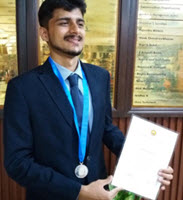
Hydrocarbon-degrading microbes living in ocean environments consumed and metabolized oil droplets following Deepwater Horizon, which significantly influenced the oil’s fate in the Gulf of Mexico. The ocean has layers of varying densities resulting from temperature or salinity gradients that can affect the motion of oil droplets and swimming microbes. Understanding the hydrodynamics of droplets and swimming microbes as they encounter these ocean layers is vital to understanding the biodegradation processes that follow an oil spill.
Rajat Dandekar uses mathematical theory to derive how stratified ocean environments affect the motion of flagellated organisms (microbes that move using a whip-like appendage called a flagella) and the movement of floating particles such as oil droplets. His research will improve our understanding about how stratified ocean environments influence the transport of oil droplets and microbial degradation processes.
Rajat is a Ph.D. student with Purdue University’s Department of Mechanical Engineering and a GoMRI Scholar with the project Role of Microbial Motility for Degradation of Dispersed Oil.
His Path
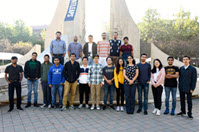
During his childhood in Pune, India, Rajat discovered that he could use mathematics and a simple pen and paper to make logical deductions about nature. He recalls learning about the golden ratio and Fibonacci sequence in flowers and plants, finding satisfaction in applying mathematical principles to the natural world. He completed a Bachelor of Technology in Engineering Design and Master of Technology in Automotive Engineering at the Indian Institute of Technology Madras, where he was introduced to fluid dynamics. “I learned that physical phenomena involving fluid motion can be understood by reducing their physics to a set of equations and then solving those equations,” he said. “The realization that mathematics, which already fascinated me, could be used to study real-world problems got me more interested in the field of fluid dynamics.”
Rajat began researching fluid dynamics Ph.D. programs and read several research papers detailing complex flow experiments conducted by Dr. Arezoo Ardekani at Purdue University. Dr. Ardekani’s lab team combined theoretical and computational techniques to investigate the motion of swimming microorganisms and transport of particles and droplets in aquatic environments. Rajat was intrigued by the group’s methods and joined Dr. Ardekani’s team conducting GoMRI-funded research investigating how oil-water interfaces affect marine bacteria’s motility as they move towards and attach to dispersed oil.
His Work
To understand Rajat’s research, it’s helpful to start with how microorganisms swim. “Humans swim by pushing through water with their body. However, microorganisms are typically very small and cannot exert such inertial forces on the fluid,” he explained. “Instead, these organisms have evolved so that they can propel themselves through ocean and lake environments. For example, some organisms rhythmically beat their flagella, while some synchronize cilia on their surface in such a way that the organism is able to move itself.”
Rajat focused first on understanding how stratified ocean environments affected flagellated organisms’ speed and energy consumption. He spent a semester conducting a literature review and learning more-nuanced mathematical techniques. He then derived equations using a mathematical technique called perturbation theory, which incorporated the complex Navier-Stokes equations that describe fluid motion into his calculations of flagellated organisms’ movement. He observed that density variations in the ocean significantly reduced flagellated organisms’ speed and caused them to consume more energy while swimming.
Rajat turned his focus next to calculating the transport of particles in stratified oceans, including their rotation and if they experience force and torque. He utilized his understanding of perturbation theory to develop a mathematical solution for calculating these particles’ rotation and the force and torque they experience in aquatic environments. “The theory can be applied for analyzing the motion of particles with any arbitrary shape [such as oil droplets],” explained Rajat. “An important application [of the theory] is the motion of droplets in aquatic environments, which can be used to understand oil droplets’ motion during an oil spill.”
Rajat’s theory revealed that even weak density variation generated more drag on particles than did fluid with a constant density. His calculations indicate that skew particles (particles that are highly deformed and asymmetric) experience hydrodynamic torque and rotate due to density stratification while non-skew particles (particles with shapes including spheres, ellipses, cubes, and rods) do not. He and his colleagues are now applying this theory to oil droplets (which can be skew or non-skew depending on their shape) to better understand their movement in stratified oceans.
His Learning
The friendly and motivating atmosphere in Dr. Ardekani’s lab created a positive environment that helped Rajat grow as a researcher and individual. He recalled having stimulating discussions with lab members about the research and each other’s philosophies and receiving encouragement from Dr. Ardekani to keep improving the research’s quality without stopping too early. Rajat further learned the value of discussing research with experts and other graduate students in the field when he presented his research at the 2019 American Physical Society’s Division of Fluid Dynamics Annual Meeting. His conference experience motivated him to pursue the next phase of his research: understanding the motion of flagellated microorganisms in heterogeneous media.
Rajat hopes to continue conducting research on exciting issues. “Many times, you are unsure whether the problem you are looking at is solvable with the scientific means at your disposal,” he said. “I am learning to embrace the uncertainty associated with conducting research.”
Praise for Rajat
Dr. Ardekani praised Rajat’s creativity, dedication, innovation, and theoretical skillset and described him as a brilliant student. She explained that Rajat’s research has made important contributions to the field of fluid dynamics by developing theoretical descriptions of particle transport and motile organisms in different fluid media. “Rajat joined my group when he started his Ph.D. in the fall of 2018,” she said. “Since then, he has impressed me in every meeting with his progress and productivity.”
The GoMRI community embraces bright and dedicated students like Rajat Dandekar and their important contributions. The GoMRI Scholars Program recognizes graduate students whose work focuses on GoMRI-funded projects and builds community for the next generation of ocean science professionals.
By Stephanie Ellis and Nilde Maggie Dannreuther. Contact sellis@ngi.msstate.edu for questions or comments.
************
The Gulf of Mexico Research Initiative (GoMRI) is a 10-year independent research program established to study the effect, and the potential associated impact, of hydrocarbon releases on the environment and public health, as well as to develop improved spill mitigation, oil detection, characterization and remediation technologies. An independent and academic 20-member Research Board makes the funding and research direction decisions to ensure the intellectual quality, effectiveness and academic independence of the GoMRI research. All research data, findings and publications will be made publicly available. The program was established through a $500 million financial commitment from BP. For more information, visit http://gulfresearchinitiative.org/.
© Copyright 2010-2020 Gulf of Mexico Research Initiative (GoMRI) – All Rights Reserved. Redistribution is encouraged with acknowledgement to the Gulf of Mexico Research Initiative (GoMRI). Please credit images and/or videos as done in each article. Questions? Contact web-content editor Nilde “Maggie” Dannreuther, Northern Gulf Institute, Mississippi State University (maggied@ngi.msstate.edu).

The Alabama Center for Ecological Resilience (ACER) Consortium fact sheet series highlights the project’s research groups and their scientific focuses. These materials can be used as a classroom resource for science teachers on in the northern Gulf Coast research and for those with a general interest in oil spill research.
A brief introduction to ACER and what they do. Click on the image or here to open the publication.
The Consumer research group focused on the top predators of the northern Gulf of Mexico ecosystem. Click on the image or here to open the publication.
The Wetland research group focused on the flora and fauna of coastal wetlands. Click on the image or here to open the publication.
The Oyster research group focused on the intertidal and subtidal oyster reefs along the northern Gulf Coast. Click on the image or here to open the publication.
The Nitrogen Cycling research group focused on the processes that convert nitrogen from one form to another in coastal habitats. Click on the image or here to open the publication.
The Microplankton research group focused on how plankton, specifically plankton between 0.02 – 0.2 mm in size, are affected by oiling and the response to oiling (i.e. the use of dispersants). Click on the image or here to open the publication.
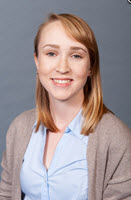
The microbial community living in fish’s gastrointestinal tracts, also called the gut microbiome, are vital to their developing immune systems and can influence behaviors such as foraging. Studies conducted following Deepwater Horizon observed that crude oil exposure can shift the gut microbiome’s community structure to favor microbes that can degrade toxic oil chemicals. Determining if oil exposure triggers similar responses in other Gulf of Mexico fish species and if their foraging behaviors change is important to understanding their risk to oil exposure.
Maggie Wigren is investigating how toxic polycyclic aromatic hydrocarbons (PAHs) in weathered oil affect the gut microbiomes and foraging behavior of sheepshead minnows, a small fish that lives in the estuarine environments surrounding the Gulf of Mexico. The presence of oil-degrading microbes in the minnows’ guts could serve as bioindicators of polluted areas and potentially decrease the bioaccumulated oil load in fish.
Maggie is a master’s student with Purdue University’s Department of Forestry and Natural Resources and a GoMRI Scholar with the project Integrating Teleost Transcriptomes to Identify Ecologically Meaningful Responses Following Oil Exposure.
Her Path
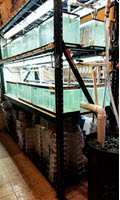
As a child, Maggie was fascinated by fish and marine environments and spent most of her childhood swimming, fishing, and wading through streams. She developed a passion for understanding and protecting natural ecosystems that inspired her to pursue an ecology and environmental science undergraduate degree at Purdue University. There, she became interested in disease ecology and ecotoxicology in aquatic habitats and accepted a graduate student position in Dr. Marisol Sepulveda’s ecotoxicology lab conducting GoMRI-funded research that investigates how different fish species respond to oil exposure.
“When I heard about the devastation that the Deepwater Horizon oil spill caused, I felt helpless,” said Maggie. “I’ve always been passionate about preserving and protecting natural areas, so when I found an opportunity to do research that could help inform oil spill response efforts, I was eager to start. I hope that the more we know about the broad, negative impacts of oil spills, the more our society can work towards more environmentally friendly policies and cleaner forms of energy.”
Her Work
Maggie conducted experiments to observe how oil affects microbial communities in the minnows’ guts and examine minnow foraging behaviors before and after oiling. She used a high-speed blender to thoroughly mix 1 gram of weathered Deepwater Horizon oil in 1 liter of artificial seawater, creating a high-energy water-accommodated fraction or HEWAF (a homogenous oil-water solution). She exposed 5 fish to a 5% concentration of the HEWAF solution for 7 days, changing the water daily to maintain the oil dose and repeated this process three times.
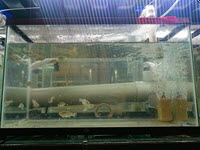
For the microbiome experiments, Maggie dissected and extracted DNA from the fish’s gastrointestinal tracts after the 7-day exposure. DNA analysis from 16S rRNA and shotgun metagenomic sequencing will tell her which bacteria are present and their functions. The data analysis is still ongoing, but early results show trends that suggest oil exposure alters the gut microbiome composition in sheepshead minnows and increases the abundance of oil-degrading bacteria.
For the foraging experiments, Maggie observed the number of prey items fish captured at the beginning and end of the 7-day exposure. She released 10 zooplankton (Daphnia magna) into the oil treatment and control tanks and mounted a GoPro action camera to record how many zooplankton the fish consumed within 3 minutes. Surprisingly, oil-exposed fish exhibited higher prey capture rates than control fish, the opposite of her initial hypothesis. She theorizes that the oil-exposed fish may be attempting to acquire more nutrients while in a stressed state and hopes that future studies will investigate this possibility further.
Maggie hopes that her research will help demonstrate the broad effects of oil exposure on non-game and sporting fish. “Although most people don’t think about minnows, they are an important foraging fish for other larger, more economically important fish species,” she said. “By observing oil’s effect on the minnows’ microbiome, we can create a broader toxicological profile for oil contamination in fish, which could help identify bacteria that are potential bioindicators of pollution.”
Her Learning
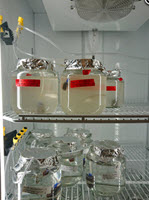
Maggie entered Dr. Sepulveda’s lab without any toxicology or microbial ecology experience and was initially overwhelmed with figuring out how to conduct microbiome research and dealing with equipment issues. Despite these obstacles, she found support in her peers, advisor, and advisory committee, finding that talking out her struggles cleared her mind, led her to solutions, and improved her communication and collaboration skills. “The whole process of designing, executing, and analyzing my own experiment has helped me grow significantly as a scientist and become more independent,” she said.
Maggie recalls that she felt intimidated the first time she attended a large scientific conference but learned from fellow attendees that everyone experiences imposter syndrome at some point in their career. “It was very eye-opening and refreshing to listen and talk to fellow scientists in the field,” she said. “I came back revitalized and ready to tackle the rest of my project with new ideas about how to analyze my results.” She is grateful that she can contribute meaningful research towards oil spill science and ecosystem preservation as a member of the GoMRI science community.
Maggie plans to move to Vancouver, British Columbia, after graduating and pursue a career in environmental consulting, marine conservation research, or outreach that fosters scientific literacy and environmental stewardship. She feels that it is important to learn from those in fields that interest you. “Take advantage of any and all resources that come your way and expand your network of fellow scientists,” she said. “Don’t be afraid to step outside of your comfort zone, and don’t hesitate to ask for help when you need it. There is no shame in reaching out for support among your peers and advisors.”
Praise for Maggie

Maggie’s research is the first microbiome study conducted in Dr. Sepulveda’s lab, who explained that Maggie was instrumental in designing the experiment and developing and implementing the study’s different protocols, including the protocols for 16S rRNA sequencing and metagenomics. “I have watched Maggie grow as a scientist over the past 2+ years,” she said. “I think her work is unique and will advance our field. She has a bright future ahead of her!”
The GoMRI community embraces bright and dedicated students like Maggie Wigren and their important contributions. The GoMRI Scholars Program recognizes graduate students whose work focuses on GoMRI-funded projects and builds community for the next generation of ocean science professionals.
By Stephanie Ellis and Nilde Maggie Dannreuther. Contact sellis@ngi.msstate.edu for questions or comments.
************
The Gulf of Mexico Research Initiative (GoMRI) is a 10-year independent research program established to study the effect, and the potential associated impact, of hydrocarbon releases on the environment and public health, as well as to develop improved spill mitigation, oil detection, characterization and remediation technologies. An independent and academic 20-member Research Board makes the funding and research direction decisions to ensure the intellectual quality, effectiveness and academic independence of the GoMRI research. All research data, findings and publications will be made publicly available. The program was established through a $500 million financial commitment from BP. For more information, visit http://gulfresearchinitiative.org/.
© Copyright 2010-2020 Gulf of Mexico Research Initiative (GoMRI) – All Rights Reserved. Redistribution is encouraged with acknowledgement to the Gulf of Mexico Research Initiative (GoMRI). Please credit images and/or videos as done in each article. Questions? Contact web-content editor Nilde “Maggie” Dannreuther, Northern Gulf Institute, Mississippi State University (maggied@ngi.msstate.edu).

Because oil and water don’t mix easily, oil droplets in the ocean environment tend to aggregate into larger masses, which hinders microbial degradation. Chemical dispersants used for oil spill response contain water-soluble and oil-soluble components that adhere to oil droplets and increase the oil and water’s compatibility, allowing oil to disperse more easily into the water column and enhancing microbial consumption. However, because chemical dispersants require constant energy input from waves, wind, and currents to keep the oil dispersed, they typically only slow oil’s coalescence rather than prevent it.
Chris Keller is developing a dispersant system that combines silica nanoparticles and polymer surfactants and doesn’t require energy input to generate stable oil emulsions. His goal is to identify which combination of these compounds will maximize oil entrapment and dispersion while minimizing harm to marine life.
Chris is a Ph.D. student with Tulane University’s Department of Chemistry and a GoMRI Scholar with the project Designing Nanoparticle-Based Dispersants with Improved Efficiency and Biocompatibility.
His Path

Chris’s interest in science began with his Mandeville, Louisiana, high school chemistry teacher, whose passion for science and its ability to change the world inspired him. He discovered a knack for scientific research while performing basic lab experiments, often modifying the experimental conditions for efficiency. His interest in chemistry eventually evolved into a passion for polymer science.
As an undergraduate polymer science student at the University of Southern Mississippi, Chris investigated the drug delivery applications of different biopolymers in Dr. Daniel Savin’s polymer science lab. He recalls assisting Kyle Bentz, who was then a graduate student in the lab, with his GoMRI-funded research on nanoparticle-based oil dispersants. The research held great significance to Chris, who is from the Louisiana coast, where oil spills and chemical dispersants can affect the local ecosystem and marine life for years. “When I was accepted to Tulane University as a Ph.D. student, little did I know that I would be continuing that same GoMRI research under the direction of Dr. Scott Grayson,” said Chris. “By researching alternative methods to cleanup oil spills, I feel that I am contributing to measures that can help lessen their impacts and ensure that an oil spill isn’t a defining event for a region’s ecosystem.”
His Work
Chris is continuing the research of Dr. Kyle Bentz and Dr. Muhammad Ejaz investigating polymer-modified silica-based nanoparticles as a new system of oil dispersants. Chris’s team hypothesizes that once the nanoparticle system entraps the oil, the oil’s density will change so that it floats to the ocean surface for collection via skimming. This process could be repeated as many times as necessary to help spill response efforts. Chris is designing the nanoparticle system and observing the nanoparticles’ reactions with unimolecular micelles (single-molecule surfactant polymers that don’t require energy input to generate stable oil emulsions).

The nanoparticle system is made up of a silica-based core with a copolymer chain attached to it that contains both hydrophobic (oil-soluble) and hydrophilic (water-soluble) polymer molecules. The hydrophobic polymer drives the entrapment of oil while the hydrophilic polymer helps disperse the oil into the water column. Chris has found that there is a delicate balance between the ratio of these two polymers that dictates if the system will exhibit the right properties for real-world application. For example, too many hydrophobic molecules could trap oil too quickly, changing the oil’s density so that it rises to the surface earlier than desired, but too many hydrophilic molecules could slow the rate of oil entrapment and reduce the amount of oil that disperses. Too many polymer molecules overall could create particles that are too large to effectively disperse the oil and may affect marine organisms.
So far, Chris has observed preliminary evidence of oil entrapment and established the minimum number of hydrophilic molecules required to disperse the oil particles in water (up to tens of milligrams per milliliter of water). He is currently adjusting the ratio of hydrophobic and hydrophilic molecules to identify combinations that will return the same or better results. To do this, he tests various nanoparticle-micelle mixtures under an inert (not chemically active) nitrogen atmosphere and observes their reactions over time. He examines if simple shaking will disperse the modified particles in water and, if so, records what concentrations are needed to prevent the particles falling to the bottom of the test vial. Each reaction’s success is determined by the amount of polymer that effectively attaches to the nanoparticle surface. He uses a centrifuge to isolate the nanoparticle system and collect the free polymers that did not attach during the reaction. Analyzing the unattached polymers can provide a rough approximation of the size of the polymers that attached to the nanoparticle surface.
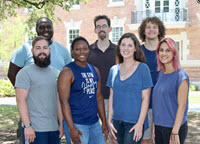
Chris sends batches of different polymer-modified nanoparticles to collaborating labs to be analyzed for toxicity and effectiveness in entrapping oil. He constantly adjusts his experimental set up based on his colleagues’ findings on the different formulations. “At the end of the day, it’s about a real-world application. Their results help me adjust the polymer makeup to find a system that will meet our goal: the most oil entrapment with the least environmental impact,” explained Chris. “Furthermore, Dr. Savin’s lab at the University of Florida is developing a different polymer-modified nanoparticle system to test against mine to see which one yields better results.”
Once the new dispersant system’s design is complete, Chris will fine-tune the system so that industry can scale it up for real-world application. While the system is being developed with oil spill mitigation in mind, there are other potential uses of the team’s nanoparticle dispersant system. “Future applications other than dispersants are going to largely depend on how ‘biofriendly’ we can make these,” explained Chris. “For example, an undergraduate student working on his senior thesis under my guidance is examining the use of sugar-based nanoparticles. If we can utilize a different core such as sugar instead of silica, I think we could potentially see some use as drug carriers or filtration devices later down the line.”
His Learning
Dr. Grayson taught Chris to take his research one goal at a time and emphasized collaboration’s important role in achieving those goals. Being a part of the GoMRI community keeps Chris mindful of the broader implications of his research. For example, Chris’s close focus on his laboratory research sometimes caused him to forget that, while his research has applications for oil spill response, research contributing to other applications is just as important. “When I go to the Gulf of Mexico Oil Spill and Ecosystem Science conference, I get to see the other researchers’ perspectives first-hand and consider things that I wouldn’t have thought about on my own,” he said. “It makes me a more well-rounded researcher.”
As Chris nears graduation, he prepares his research for the next cohort of graduate students to continue. “Science is a marathon, not a sprint, and is met with a lot of ‘brick walls’ and frustration,” said Chris. “Having patience, taking a step back, and looking at it from different perspectives [makes it possible to] change the world one small victory at a time. The experiments won’t always work, but that’s the point of research.”
Praise for Chris
Dr. Grayson praised how Chris tested the team’s theory that silica nanoparticles modified with surfactant polymers could successfully stabilize oil mixtures in water. He explained that Chris’s experiments built upon previous research to include more oil dispersion processes and remove high temperatures associated with synthesizing the polymers and nanoparticles. “Chris has done a great job working on this theory,” said Dr. Grayson. “It appears in these last few months that he will finally achieve everything that we had hoped for: an environmentally friendly, non-toxic oil dispersant.”
The GoMRI community embraces bright and dedicated students like Chris Keller and their important contributions. The GoMRI Scholars Program recognizes graduate students whose work focuses on GoMRI-funded projects and builds community for the next generation of ocean science professionals.
By Stephanie Ellis and Nilde Maggie Dannreuther. Contact sellis@ngi.msstate.edu for questions or comments.
************
The Gulf of Mexico Research Initiative (GoMRI) is a 10-year independent research program established to study the effect, and the potential associated impact, of hydrocarbon releases on the environment and public health, as well as to develop improved spill mitigation, oil detection, characterization and remediation technologies. An independent and academic 20-member Research Board makes the funding and research direction decisions to ensure the intellectual quality, effectiveness and academic independence of the GoMRI research. All research data, findings and publications will be made publicly available. The program was established through a $500 million financial commitment from BP. For more information, visit http://gulfresearchinitiative.org/.
© Copyright 2010-2019 Gulf of Mexico Research Initiative (GoMRI) – All Rights Reserved. Redistribution is encouraged with acknowledgement to the Gulf of Mexico Research Initiative (GoMRI). Please credit images and/or videos as done in each article. Questions? Contact web-content editor Nilde “Maggie” Dannreuther, Northern Gulf Institute, Mississippi State University (maggied@ngi.msstate.edu).
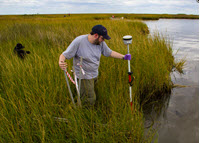
Shearing typically occurs along coastal marshes when strong storms rip away the plants at the marsh edge. Because oiled shoreline sediment is in a weakened state and less able to securely hold plants in place, some Louisiana marshes that were heavily oiled following Deepwater Horizon are experiencing more shearing than usual. The loss of vegetation adversely affects the entire marsh ecosystem.
Patrick Rayle uses metabarcoding methods to examine differences in meiofauna biodiversity in oiled and unoiled Louisiana marshes that have experienced shearing. His research can help us better understand how meiofauna communities respond to these co-occurring stressors. He also wants to help answer questions about whether losing the marsh edges through erosion will diminish the diversity of this unique intertidal ecosystem.
Patrick is a master’s student with the Louisiana State University AgCenter’s Department of Entomology and a GoMRI Scholar with the project A Study of Horse Fly (Tabanidae) Populations and Their Food Web Dynamics as Indicators of the Effects of Environmental Stress on Coastal Marsh Health.
His Path
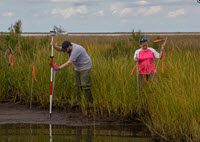
Patrick’s father is a biologist for a Louisiana environmental consulting firm, which made biology a common dinner table topic that Patrick really enjoyed growing up. Later, while completing a marine-focused biological sciences undergraduate degree at Louisiana State University, Patrick worked with Dr. Ken Brown, a Coastal Waters Consortium team member investigating how Deepwater Horizon oiling affected marsh microbial communities. Afterwards, he eagerly accepted a graduate research position with Dr. Lane Foil and Dr. Claudia Husseneder, who were also investigating Deepwater Horizon impacts on Louisiana marshes.
“I’ve lived my entire life just outside of New Orleans, and the various disasters that the community experienced over the years had a large impact on my life,” said Patrick. “When the oil spill hit, it was extremely frustrating that, as a teenager, there really wasn’t much I could do about it. Working on this research examining long-term effects of the spill has been cathartic for me – it feels like I can make a difference in the response the next time something like this happens.”
His Work
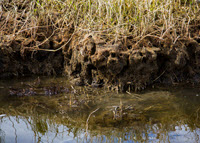
Patrick collects soil samples from six Barataria Bay marsh sites using a Barrett soil coring device equipped with replaceable acrylic cores for extracting large, consistently-sized soil samples with minimal cross-contamination risks. He collects five samples at each site from increasing elevations that are .05m apart. Then, he extracts DNA from the samples and uses polymerase chain reaction (PCR) to amplify the short eukaryotic 18S region of the DNA and capture DNA sequences for the microscopic meiofauna living in the soil.
Patrick applies Illumina Hi-seq DNA sequencing techniques to the amplified region to reveal the exact sequence of each organism in the sample. Using bioinformatics algorithms, he matches the regions with previously identified and sequenced species available in a public DNA database. This process generates a table of all the species matched to the collected organisms, which Patrick uses to examine biodiversity differences between healthy and sheared sites that experienced oiling.
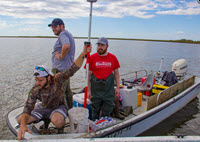
Patrick’s early results show that sheared sites exhibited lower biodiversity than intact sites, which he hypothesizes may have been caused by plant loss associated with oiling. He is conducting a similar study examining biodiversity differences between sites that experience different salinity conditions. “I want to focus on salinity as well, because of the proposed mid-Barataria Bay freshwater diversions,” he explained. “These diversions are intended to help rebuild Louisiana marshes by reconnecting them to the Mississippi River’s sediment input. However, they will have a wide variety of effects on the marshes simply by changing the salinity regime. I want to determine what changes in meiofauna biodiversity are likely to happen in marsh areas with changing salinity.”
His Learning
Patrick is grateful to Drs. Foil and Husseneder for their mentorship, which improved important skills for his future scientific career. He recalls that Dr. Foil hosted a writing course to hone his writing skills for academic journals and that Dr. Husseneder patiently shared her extensive genetics knowledge with him. They also encouraged Patrick to attend the Second Benthic Invertebrate Taxonomy, Metagenomics, and Bioinformatics (BITMaB-2) Workshop, which gave him a solid foundation to conduct analyses using specialized bioinformatics programs.
“To me, GoMRI is about learning from and mitigating a major environmental disaster,” said Patrick. “The Deepwater Horizon spill is too large of an issue to be solved by any one researcher, but collectively we can make new discoveries that can aid in the recovery and prevention of issues like this in the future.”
Patrick also realized that his early research experiences helped him as a graduate student. “There are numerous opportunities available to students at the undergraduate level, but you have to look for them,” he said. “Many citizen science programs can give you a better idea of what type of work is required to do research.”
Moving forward, Patrick wants to pursue an environmental science position in industry or government.
Praise for Patrick
Drs. Foil and Husseneder praised Patrick’s adaptability in difficult conditions, saying that he applied his Eagle Scout skills and values to many aspects of the research. “He confidently navigated the Gulf of Mexico estuary, trekked through muddy marshes in all weather conditions, fought through the jungle of bioinformatics, and showed great perseverance in his endeavors,” said Dr. Husseneder. “Patrick is on his way to becoming a well-rounded biologist, i.e., not afraid to tackle mucky field work, big data, and computer command lines.”
Dr. Husseneder said that Patrick’s work is an example of the collaborative nature of the GoMRI program since his research is integrally linked with his fellow graduate students’ projects. “Data from Patrick’s study dovetail with projects of former GoMRI scholars, including food web studies on horse flies (Devika Bhalerao), marsh insects (Ben Aker), and sea side sparrows (Allison Snider).”
The GoMRI community embraces bright and dedicated students like Patrick Rayle and their important contributions. The GoMRI Scholars Program recognizes graduate students whose work focuses on GoMRI-funded projects and builds community for the next generation of ocean science professionals.
By Stephanie Ellis and Nilde Maggie Dannreuther. Contact sellis@ngi.msstate.edu for questions or comments.
************
The Gulf of Mexico Research Initiative (GoMRI) is a 10-year independent research program established to study the effect, and the potential associated impact, of hydrocarbon releases on the environment and public health, as well as to develop improved spill mitigation, oil detection, characterization and remediation technologies. An independent and academic 20-member Research Board makes the funding and research direction decisions to ensure the intellectual quality, effectiveness and academic independence of the GoMRI research. All research data, findings and publications will be made publicly available. The program was established through a $500 million financial commitment from BP. For more information, visit https://gulfresearchinitiative.org/.
© Copyright 2010-2019 Gulf of Mexico Research Initiative (GoMRI) – All Rights Reserved. Redistribution is encouraged with acknowledgement to the Gulf of Mexico Research Initiative (GoMRI). Please credit images and/or videos as done in each article. Questions? Contact web-content editor Nilde “Maggie” Dannreuther, Northern Gulf Institute, Mississippi State University (maggied@ngi.msstate.edu).
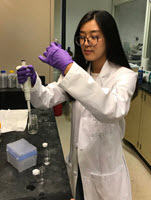
Oil-water interfaces, such as those formed by marine oil spills or natural ocean oil seeps, are teeming with bacterial activity. Some bacterial species in those interfaces form biofilms that help break up oil, which enhances biodegradation. The interfaces themselves can also significantly influence how bacteria behave, often trapping them or altering their natural movements.
Jiayi Deng tracks different bacteria movement patterns at the point where oil and water meet to explore key processes involved with interactions between oil spills and marine microorganisms. Information that she is uncovering about bacterial propulsion, structure, and interactions with interfaces and other bacteria can help researchers design bio-mimic microrobots and develop strategies to guide their motion towards oil spills for oil collection.
Jiayi is a Ph.D. student with the University of Pennsylvania’s Department of Chemical and Biomolecular Engineering and a GoMRI Scholar with the Dispersion Research on Oil: Physics and Plankton Studies III (DROPPS III) consortium.
Her Path
Jiayi’s parents are engineers who sparked her desire to solve real-world problems at a young age. She described chemical engineering as an art that uses fundamental ideas and physics to interpret natural processes and can be applied to all aspects of human life, including pharmaceuticals, biotechnology, and energy and environmental engineering. Jiayi completed a chemical engineering undergraduate degree at Dalian University of Technology and a chemical and biomolecular engineering master’s degree at the University of Pennsylvania.

As a master’s student, Jiayi learned about soft matter (such as liquids and colloids) while working with polymers in Dr. Daeyeon Lee’s Soft Materials Research and Technology lab. She later took a course taught by Dr. Kathleen Stebe, a co-principal investigator with the GoMRI-funded DROPPS consortium, that described how surface energy can dominate some interfacial phenomena and what that means for designing functional materials.
“I was fascinated by the complex structures formed on interfaces and how these phenomena can be explained using the physics and fundamental concepts of colloid and interface science,” said Jiayi. “I contacted Dr. Stebe and gained a great opportunity to join her GoMRI research into bacterial dynamics at the oil-water interface as a Ph.D. student.”
Her Work
Jiayi studies the swimming behavior of lab-cultured Pseudomonas aeruginosa (strain PAO1), a marine species that forms an elastic biofilm at the oil-water interface and consumes hydrocarbons. She conducts her experiments in a 1-centimeter cylinder with an aluminum bottom half and a Teflon top half that intersect in the middle, creating a planar interface. After adding bacteria suspended in an aqueous solution and then hexadecane to form an oil-water interface, she uses an upright bright-field microscope and a high-speed camera to observe the interfacial interactions and capture one-minute videos at 60 frames per second.
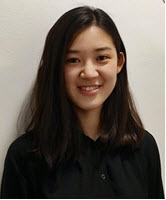
Next, Jiayi interprets the bacteria’s position in each frame using a multiple particle tracking algorithm to determine their motion. She observes several metrics that provide insight into bacterial swim behavior: swim speed, the curvature of their circular path, how fast they complete a circular path, time spent moving forward and backward, and the dynamics of different bacteria types. So far, she has observed four distinct trajectories affecting how bacteria move: (1) movement driven by collision, (2) swimming in curly paths, (3) swimming in pirouette motions, and (4) interactions with other bacteria that enter and exit the interface freely.
Jiayi developed a method to analyze hydrodynamic interactions between the bacteria and the interface. She places passive tracer particles at the interface before adding hexadecane and then measures the correlated motion between bacteria and passive tracers to determine how active bacteria displace tracer particles. “This displacement field shows how bacteria interact with passive colloids (inactive suspensions of particles) and small molecules,” explained Jiayi. “By measuring their correlated motions, we can directly measure the hydrodynamic flow field around the swimming bacteria at small time scales.”
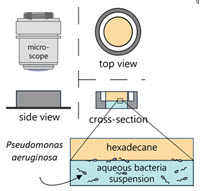
Using this method, Jiayi found that swimming microbes greatly enhance interfacial mixing by a factor of three. She observed two main dynamics: (1) bacteria that are trapped at the interface perform curly, diffusive, and pirouette motions and (2) bacteria that freely enter and exit the interface closely interact with the trapped bacteria. “The persistent curvilinear trajectories (i.e., curly or pirouette trajectories) of interface-trapped particles differ significantly from motions in the bulk. Interface trapping makes these motions quite stable, creating a convective flow around the swimmers,” explained Jiayi. “These microswimmers can generate flows in both the interface and the surrounding phases, breaking the oil spill into smaller droplets that are easier for microbes near the interface to digest.”
Her Learning
Dr. Stebe helped Jiayi understand the value of being passionate and thinking creatively beyond the original research goal, which typically becomes broader as an experiment develops. Jiayi and her colleagues discovered additional bacteria behaviors at the interface related to their adhesion state and hydrodynamical interactions with the oil-water interfaces. “We were excited by their different modes of motion and studied these motions using hydrodynamics and interfacial science, but we also wanted to explore their applications on interfacial transport,” said Jiayi. “Interacting with people from other fields and breaking the patterns and traditional ways of thinking helped us reach more creative solutions.”
Her Future
Jiayi hopes to find a post-doctoral position in academia where she can continue conducting chemical or biological engineering research.
The GoMRI community embraces bright and dedicated students like Jiayi Deng and their important contributions. The GoMRI Scholars Program recognizes graduate students whose work focuses on GoMRI-funded projects and builds community for the next generation of ocean science professionals. Visit the DROPPS website to learn more about their work.
By Stephanie Ellis and Nilde Maggie Dannreuther. Contact sellis@ngi.msstate.edu for questions or comments.
************
The Gulf of Mexico Research Initiative (GoMRI) is a 10-year independent research program established to study the effect, and the potential associated impact, of hydrocarbon releases on the environment and public health, as well as to develop improved spill mitigation, oil detection, characterization and remediation technologies. An independent and academic 20-member Research Board makes the funding and research direction decisions to ensure the intellectual quality, effectiveness and academic independence of the GoMRI research. All research data, findings and publications will be made publicly available. The program was established through a $500 million financial commitment from BP. For more information, visit https://gulfresearchinitiative.org/.
© Copyright 2010-2019 Gulf of Mexico Research Initiative (GoMRI) – All Rights Reserved. Redistribution is encouraged with acknowledgement to the Gulf of Mexico Research Initiative (GoMRI). Please credit images and/or videos as done in each article. Questions? Contact web-content editor Nilde “Maggie” Dannreuther, Northern Gulf Institute, Mississippi State University (maggied@ngi.msstate.edu).

Meiofauna are microscopic marine organisms that live between grains of sand in ocean, coastal, river, and stream sediments and provide important services such as recycling organic material in the sediment that contribute to healthy marine ecosystems. Additionally, meiofauna are intermediary consumers between microbes and prey of larger organisms in marine food webs, and as such, can be early indicators of environmental disturbances, such as oil spill pollution, that could affect broader ecosystem health.
Joseph Sevigny uses genetic research techniques to expand our knowledge about meiofauna taxonomy and improve the way we analyze and monitor these communities. His work to develop novel methods for efficient genomic analysis can reduce the time it takes researchers and responders to survey and monitor how meiofaunal communities recover from environmental disturbances.
Joseph is a Ph.D. student with the University of New Hampshire’s Hubbard Center for Genome Studies and a GoMRI Scholar with the project Genomic Responses to the Deepwater Horizon Event and Development of High-Throughput Biological Assays for Oil Spills.
His Path
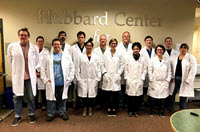
Joe has been fascinated with understanding how the natural world works since he was a child. Reading scientific authors such as Matt Ridley and Richard Dawkins sparked his interest in the engaging world of genetics, genomics, and computational biology. He began his undergraduate career as a Biology and Environmental Science dual major at New England College and conducted bioinformatics and genetics research full-time during the summer of his junior year. He collaborated with several institutions, including the University of New Hampshire’s Hubbard Center for Genome Studies, where he learned about Dr. Kelley Thomas’s GoMRI-funded research characterizing the taxonomy of benthic organisms such as meiofauna.
Joe’s work during that summer solidified his passion for comparative genomics research, and he later joined Dr. Thomas’s lab as a Ph.D. student. “Meiofauna don’t have the means to move to a different location after an environmental disturbance – they are stuck dealing with whatever comes into their homes,” he explained. “I want to help improve the way we analyze and monitor these communities through DNA sequencing and highlight their importance for investigating the impacts of oil spills.”
His Work
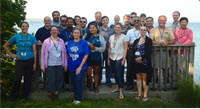
The first and most challenging step of Joe’s research was collecting and preparing the meiofauna for genomic analysis. Because most meiofauna species have not undergone genetic sequencing, he had to start from scratch. Joe and his colleagues developed techniques to sequence trace amounts of DNA from meiofauna but still needed to taxonomically identify them before they could proceed.
Since they are investigating a broad group of meiofauna (26 of the 35 known animal phyla), they needed help from taxonomic experts, so the team coordinated workshops such as the Benthic Invertebrate Taxonomy, Metagenomics, and Bioinformatics (BITMaB) with invited meiofaunal taxonomists from around the world. During the workshop, attendees collected and identified Gulf of Mexico meiofauna, which allowed them to sequence an extremely broad range of meiofaunal groups.
“This monumental task would have been impossible without collaborating with traditional taxonomists, who collect and identify individual animals using light microscopy and other techniques,” said Joe. “Through the workshops, the taxonomists got to learn how we analyze the data during bioinformatics sessions, and we were able to learn a lot about the process of collecting and identifying a diverse array of meiofaunal species. It was a win-win for us all!”

Joe extracted and prepared DNA from the identified specimens for genetic sequencing, which provided him with short DNA fragments. He then used bioinformatics principles to develop his own computer code for existing software to analyze the genetic data. His program assembled the short DNA fragments into complete genomes, expanding them to the size of a chromosome. He then analyzed the genes in the large sequences to determine what functions the meiofauna have, the biochemical processes they are capable of, and their evolutionary relationships.
Joe’s research will help reduce the time and effort involved in monitoring meiofaunal communities. Rather than going through the expensive, time-consuming taxonomic identification process, future researchers can sequence DNA directly from an environmental sample, link the resulting sequences to the database, and infer which meiofauna are present. “This process will allow for faster, broader, and more-accurate scale analyses of meiofaunal communities and populations than ever before, allowing us to determine which areas of the Gulf are most severely impacted and focus our recovery efforts on those places,” explained Joe. “Over time, we can utilize the same data to monitor how these communities are recovering and construct baseline data across the Gulf and around the world.”
His Learning
Joe worked on different projects during his time with Dr. Thomas, including research focusing on animal phylogeny and evolution, speciation, and developmental expression experiments. These diverse projects helped balance his background in computational genomics. The genomic workshops gave Joe an opportunity to share his computational methods knowledge while learning from experts in different fields and were a highlight of his graduate studies.

“I find it extremely rewarding that I can incorporate my skillset in molecular biology towards increasing our understanding and awareness of anthropogenic impacts,” he said. “Teaching a topic I really enjoy and sharing my knowledge with the next generation of scientists is extremely rewarding and motivating. These experiences have really shown me how much science benefits from an environment in which scientists from an extremely broad set of backgrounds come together for a common goal.”
His Future
Joe plans to continue his genomics research as a post-doc and eventually serve in a faculty position.
Praise for Joe
Dr. Thomas explained that Joe has a “uniquely engaging quality” that makes it easy for him to work alongside diverse collaborators from other fields. He particularly recalled Joe’s appreciation for the taxonomists and ecologists who participated in the workshops and their reciprocal appreciation for Joe’s ability to teach them the bioinformatics needed to utilize his team’s genomic data. “I believe his success stems from the fact that Joe is genuinely interested in their work,” he said.
Dr. Thomas also praised Joe’s teaching ability. Joe teaches a week-long summer course for college instructors called Train the Trainers (T3), which is based off of the bioinformatics workshop he helped develop for the GoMRI project. “Joe loves what he does, and it shows. He always receives rave reviews and requests to teach,” said Dr. Thomas. “He has contributed mightily to our GOMRI project and has a great career ahead of him using the skills that he developed during this project.”
The GoMRI community embraces bright and dedicated students like Joe Sevigny and their important contributions. The GoMRI Scholars Program recognizes graduate students whose work focuses on GoMRI-funded projects and builds community for the next generation of ocean science professionals.
By Stephanie Ellis and Nilde Maggie Dannreuther. Contact sellis@ngi.msstate.edu for questions or comments.
************
The Gulf of Mexico Research Initiative (GoMRI) is a 10-year independent research program established to study the effect, and the potential associated impact, of hydrocarbon releases on the environment and public health, as well as to develop improved spill mitigation, oil detection, characterization and remediation technologies. An independent and academic 20-member Research Board makes the funding and research direction decisions to ensure the intellectual quality, effectiveness and academic independence of the GoMRI research. All research data, findings and publications will be made publicly available. The program was established through a $500 million financial commitment from BP. For more information, visit https://gulfresearchinitiative.org/.
© Copyright 2010-2019 Gulf of Mexico Research Initiative (GoMRI) – All Rights Reserved. Redistribution is encouraged with acknowledgement to the Gulf of Mexico Research Initiative (GoMRI). Please credit images and/or videos as done in each article. Questions? Contact web-content editor Nilde “Maggie” Dannreuther, Northern Gulf Institute, Mississippi State University (maggied@ngi.msstate.edu).

 The Loop podcast takes a deep dive into the Gulf of Mexico with the researchers studying the processes, mechanisms, and impacts of oil spills.
The Loop podcast takes a deep dive into the Gulf of Mexico with the researchers studying the processes, mechanisms, and impacts of oil spills.
Researchers from the Center for Integrated Modeling and Analysis of Gulf Ecosystems (C-IMAGE) discuss their studies with David Levin of Mind Open Media. C-IMAGE is an international research group studying mud, microbes and mammals after two mega spills, Deepwater Horizon and Ixtoc I. The goal of C-IMAGE is to advance understanding of the fundamental processes and mechanisms of marine blowouts and their consequences, ensuring that society is better-prepared to mitigate future events.
Episode 1: Overview of C-IMAGE
C-IMAGE PI Dr. Steven Murawski talks to David Levin about C-IMAGE’s research goals and the importance of integration when tackling large scale impacts. This episode is available in English and Spanish. (Transcript: English, Español)
Español:
Episode 2: The Mud and the Blood
C-IMAGE PIs Steven Murawski and David Hollander talk to David Levin aboard the R/V Weatherbird II in August 2012 about looking for Deepwater Horizon‘s impacts on Gulf of Mexico mud and fish. This episode is available in English and Spanish. (Transcript: English, Español)
Español:
Episode 3: The “Not-So-Visible” Impacts of the Deepwater Horizon Oil Spill on the Gulf of Mexico
Three years after the BP oil well disaster, scientists are struggling to understand the effects on the Gulf ecosystem. David Levin reports on the oil’s impact on the tiny creatures that form the base of the food chain. (Transcript: English)
Episode 4: Fitting the Gulf of Mexico Inside a Computer: How to Build an Ecosystem Model
David Levin talks with C-IMAGE members Cameron Ainsworth, Jason Lenes, Michelle Masi, and Brian Smith about building an ecosystem model of the Gulf of Mexico to describe how oil spills impact marine life. (Transcript: English, Español)
Episode 5: The Pressure is On!
David Levin talks with C-IMAGE PI Steven Murawski and scientists from the Technical University of Hamburg at Harburg Michael Schluter and Karen Malone about their ongoing experiments examining oil and gas droplets under high pressure to learn more about the Deepwater Horizon oil spill. (Transcript: English, Español)
Episode 6: Oil – It’s What’s for Dinner…
C-IMAGE scientists want to know more about how oil-eating microorganisms behave in the cold deep ocean to learn more about what happened to the oil from the Deepwater Horizon blowout. High-pressure experiments underway at our high pressure facility at the Hamburg University of Technology focus on how these microbes use oil and what happens to them in the process. Results from these studies may lead to a new way to clean up spills by eliminating its most poisonous ingredients. (Transcript: English, Español)
Episode 7: The Ixtoc Spill – Reflections
The Deepwater Horizon oil spill happened just a few years ago, but it might be possible to predict its impact on the Gulf by studying another major spill, one that happened in 1979. “These are two of the largest spills in the world’s history as far as blowouts go, and they were both in the Gulf of Mexico.” Wes Tunnell is a marine biologist who is looking at the aftermath of both spills. It’s almost like he’s looking at the same crime scene, separated by more than three decades. How? Give a listen. Mind Open Media producer David Levin talks to Wes Tunnell and John Farrington about their experiences during the 1979 Ixtoc spill and the applications to new blowouts thirty years late. This episode is available in English and Spanish. (Transcript: English, Español)
Español:
Episode 8: In the Mud in Mexico
“We were of the mind that with studying the Deepwater Horizon in the northern Gulf we weren’t getting a full Gulf of Mexico perspective.” Geochemist David Hollander is traveling with an international team of scientists aboard a Mexican research vessel. Over the last few years, his team has studied the effects of the 2010 Deepwater Horizon spill. But today, they’re looking back at a spill that happened 35 years ago and what they learn on this trip might help them understand the future of the Gulf. Mind Open Media producer David Levin talks to David Hollander, Joel Ortega Ortiz, Isabel Romero, Adriana Gaytán-Caballero, and Travis Washburn about their experiences on the RV Justo Sierra in the southern Gulf of Mexico during the research on the Ixtoc spill. (Transcript: English, Español)
Episode 9: Forensic Oceanography
Listen to learn how scientists reanalyzed remotely sensed data taken in the late 1970s to study the Ixtoc 1 oil spill. Dr. Chuanmin Hu and his graduate student Shaojie Sun use the Landsat and Coastal Zone Color Scanner (CZCS) data to develop “treasure maps” of oil from the IXTOC-1 spill to steer field studies. Listen in to find out how they did it. This episode is available in English and Spanish. (Transcript: English, Español)
Español:
Episode 10: The Risks for Fish
What happened to the fish in the days and weeks after the Deepwater Horizon oil spill? With a suite of exposure studies, C-IMAGE researchers are monitoring fish health after oil exposure in order to find out. Dr. Dana Wetzel and Kevan Main of Mote Marine Laboratory give fish a small does of oil through either their food, water, or the sea floor sediments, then analyze how their bodies recover. (Transcript: English, Español)
Episode 11: The Cuban Connection: Spills, Science Diplomacy
C-IMAGE collaborated with researchers from the University of Havana for the first join U.S.-Cuban expedition in over 50 years. (Transcript: English)
Episode 12: MTS TechSurge
When research and industry can communicate effectively when responding to an oil spill, both the environment and oil industry benefit from shared knowledge and new technologies. (Transcript: English)
Episode 13: For a Few Dollars More – Costs and Ecosystem Services after Spills
When oil spills are assessed through an economic viewpoint, both environmental and human impacts must be considered to provide a full picture. (Transcript: English)
Episode 14: Modeling Arctic Oil Spills
Understanding the long-term effects of arctic spills like this one could be even more urgent now than ever, as oil exploration makes its way to the North Slope of Alaska (including inside the Arctic National Wildlife Refuge). C-IMAGE has developed a computer model of the entire Gulf ecosystem, so they could test how future spills would affect the region. And now, they’re applying those tools farther north. (Transcript: English)
Episode 15: Asphalt Ecosystems
At the bottom of the Gulf of Mexico, some truly bizarre ecosystems are hiding in the darkness among the asphalt volcanoes and supporting huge colonies of unique life. C-IMAGE has been analyzing these ecosystems and reveals that if chemosynthetic communities are harmed, it could affect other environments as well. The microbes that power those communities don’t just eat chemicals in oil or asphalt—they also eat up a lot of free-floating carbon that would otherwise escape to the rest of the ocean… and eventually, get into the atmosphere, adding to global climate change. (Transcript: English)
Episode 16: Panel Discussion
For the past several years, The Loop covered the work of scientists studying the aftermath of the 2010 Deepwater Horizon oil spill. The research is winding down and this is The Loop‘s last podcast with C-IMAGE! (Transcript: English)
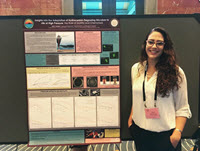
There are currently over 30 active deep-sea drilling platforms and more than 600 areas where oil naturally seeps from the Gulf of Mexico seafloor. A massive microbial response coincided with the Deepwater Horizon subsurface oil plume, leading researchers to question how pressure may have impacted the hydrocarbon degraders. Kelli Mullane is investigating how high-pressure and low-temperature affect oil-degrading microbes’ ability to detect and move toward hydrocarbon compounds. Her research will help inform how scientists and responders apply bioremediation rates to models of deep-sea hydrocarbon fate and transport.
Kelli is a Ph.D. student with the University of California San Diego’s Scripps Institution of Oceanography and a GoMRI Scholar with the project Role of Microbial Motility for Degradation of Dispersed Oil.
Her Path
Kelli grew up dreaming of becoming a marine biologist but struggled to decide which direction to take. As an environmental science undergraduate student at Rutgers University, she gained hands-on experience working in a marine biology lab studying African cichlid fish. She had just left this lab group when she was invited to complete a George H. Cook Scholar Honors Thesis, which required her to participate in ongoing lab research.
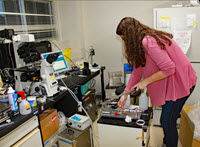
“A program director told me to search the Marine Biology department’s website for anything I thought was interesting, and I came across Dr. Costantinto Vetriani’s Deep-Sea Microbiology lab studying extremophiles (organisms that thrive in extreme conditions) at deep-sea hydrothermal vents,” said Kelli. “My microbiology knowledge was limited, but Dr. Vetriani took a chance on me and today I’m working as a Ph.D. student in a microbiology lab at one of the world’s leading oceanographic institutions.”
Kelli wanted to continue studying extremophiles in graduate school and discovered Dr. Douglas Bartlett’s high-pressure microbiology lab at the Scripps Institution of Oceanography. Their GoMRI-funded research investigates how the high pressure at the Deepwater Horizon site affected the movement of oil-degrading microbes. She was intrigued about using molecular and physiological approaches to answer questions about high-pressure environments.
“Imagine 200 elephants standing on the tip of your thumb. That’s how much pressure these deep-sea microbes experience, yet they are able to grow, divide, and interact. That’s when my curiosity kicked in!” said Kelli. “The idea that something so small survives and excels under extreme environmental conditions that would easily kill a human is mind-boggling to me.”
Her Work

Kelli investigates how high hydrostatic pressure and low temperature influence the motility (independent movement) and chemotaxis (movement towards or away from something) of deep-sea hydrocarbon-degrading microbes. She and her colleagues work with pressure-tolerant microbial strains isolated from the Gulf following Deepwater Horizon. Her findings will help explain how pressure influences microbial bioremediation rates and inform deep-sea hydrocarbon fate and transport models.
“It’s not surprising that the microbes that responded to Deepwater Horizon are pressure-tolerant rather than piezophillic (pressure-loving),” she said. “Deepwater Horizon pressures were approximately 10 – 15 MPa, which is relatively quite low considering the high pressures our lab studies. There are natural oil seeps at much deeper depths than Deepwater Horizon, and the potential for a future anthropogenic oil spill in much deeper waters is definitely there. We wanted our research to look at Deepwater Horizon-relevant pressures as well as pressures present at greater depths.”
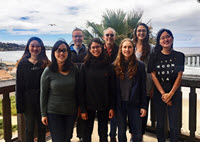
Kelli’s first experiment examined how high pressure and low temperature affect microbe motility. She worked with Kyoto University’s Dr. Masayoshi Nishiyama, who developed a small high-pressure microscopy chamber with glass windows. Kelli exposed microbes in the chamber to pressures equaling or greater than Deepwater Horizon conditions and low temperature (7°C) and recorded their movement using a high-resolution microscope. She analyzed the collected video for quantitative changes in the number and speed of swimming bacteria and observed that both factors significantly decreased microbe motility, though temperature had a greater impact on motility than pressure.
Kelli’s chemotaxis experiments will assess if in situ pressure levels inhibit microbes’ movement towards hydrocarbons (decreasing their ability to degrade hydrocarbons efficiently) or enhance it (making deep-sea biodegradation more efficient). “Researchers have investigated differences in chemotaxis-related gene expression at atmospheric and high pressure, but nobody has directly measured increased or decreased chemotaxis activity under high-pressure conditions,” she said. Kelli is developing a method to adapt previous chemotaxis studies for high-pressure research. She also plans to use transposon mutagenesis to obtain motility and chemotaxis mutants, which may help her identify genes and gene clusters important for high-pressure motility and chemotaxis.
Her Learning
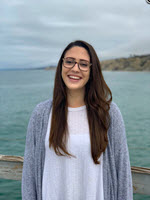
Working in Dr. Bartlett’s lab, Kelli has learned that researchers need to wear many hats. Her roles included mentoring seven undergraduate students, conceptualizing her own projects and fellowship applications, troubleshooting new protocols, and making sure the lab is well-stocked. “There is a lot that falls on my shoulders as the only Ph.D. student in the lab,” she said. “While it’s been a ton of work, it’s also made me the scientist I am today, and I wouldn’t trade that experience for anything.”
Kelli realized the value of the GoMRI science community during the 2018 Gulf of Mexico Oil Spill and Ecosystem Science (GoMOSES) conference, her first time connecting with researchers from many fields. “Getting a full sense of the community that gathered to study this oil spill was really exciting for me,” she said. “I was overjoyed to return to GoMOSES in 2019 and share the progress I’d made over the last year.” Kelli’s oral presentation at the 2019 GoMOSES conference was awarded a James D. Watkins Student Award for Excellence in Research.
Kelli believes that STEM outreach and science communication are extremely important to a scientist’s success. She currently acts as the volunteer coordinator for the Scripps Community Outreach for Public Education (SCOPE) program. The program offers free campus tours to foster scientific curiosity and environmental stewardship, provides STEM education opportunities to youth and the public, and helps graduate students improve their scientific communication and outreach skills. Kelli is also the lead coordinator for the Scripps Student Symposium (S3), a one-day conference that allows graduate students from diverse scientific backgrounds to present and discuss their research and engage in interdisciplinary collaboration.
Her Future
Kelli hopes to find a post-doc position that balances teaching and lab work so she can expand her skills and develop her long-term goals. She emphasizes to younger students that it’s okay to not know exactly what interests you, “Try something, jump in, and get your feet wet. If you realize along the way that that particular research field isn’t for you – that’s okay! Move on to a new opportunity until you find where your passion lies.”
Praise for Kelli
Dr. Bartlett said Kelli has tremendous organizational and leadership skills, including those associated with lab operations and mentoring undergraduate students. He described her as a gifted communicator able to relay her science to other researchers and to the public. “Kelli’s work performing high-pressure microscopic analyses of the motility behavior of oil-degrading Gulf of Mexico bacteria has provided an important new perspective on the factors that influence oil degradation in the deep sea.”
The GoMRI community embraces bright and dedicated students like Kelli Mullane and their important contributions. The GoMRI Scholars Program recognizes graduate students whose work focuses on GoMRI-funded projects and builds community for the next generation of ocean science professionals.
By Stephanie Ellis and Nilde Maggie Dannreuther. Contact sellis@ngi.msstate.edu for questions or comments.
************
The Gulf of Mexico Research Initiative (GoMRI) is a 10-year independent research program established to study the effect, and the potential associated impact, of hydrocarbon releases on the environment and public health, as well as to develop improved spill mitigation, oil detection, characterization and remediation technologies. An independent and academic 20-member Research Board makes the funding and research direction decisions to ensure the intellectual quality, effectiveness and academic independence of the GoMRI research. All research data, findings and publications will be made publicly available. The program was established through a $500 million financial commitment from BP. For more information, visit https://gulfresearchinitiative.org/.
© Copyright 2010-2019 Gulf of Mexico Research Initiative (GoMRI) – All Rights Reserved. Redistribution is encouraged with acknowledgement to the Gulf of Mexico Research Initiative (GoMRI). Please credit images and/or videos as done in each article. Questions? Contact web-content editor Nilde “Maggie” Dannreuther, Northern Gulf Institute, Mississippi State University (maggied@ngi.msstate.edu).
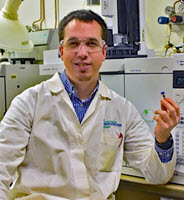
When the Deepwater Horizon incident occurred, not much was known about how conditions in the deep sea would affect oil biodegradation. Juan Viamonte uses high-pressure reactors that simulate conditions at depth to observe microbial degradation and help predict what might happen should another deep-ocean oil spill occur.
Juan is a Ph.D. student with the Hamburg University of Technology’s Institute of Technical Biocatalysis and a GoMRI Scholar with the Center for the Integrated Modeling and Analysis of Gulf Ecosystems II (C-IMAGE II).
His Path
Juan discovered his love for science when he was eighteen and searching for a career path. Unsure of what he wanted to study, he chose chemistry on a rather unorthodox basis – because a girl he liked was studying chemistry. “When I was in high school, many people already knew that they wanted to be, but I had no clue. I didn’t know that I wanted to be a scientist my whole life – I guess you could say science found me!” Juan laughed. He began a chemical engineering degree at the University of Zaragoza in his hometown in Spain. However, he believes he truly fell in love with his work while conducting undergraduate research at the University of Denmark. There, Juan discovered an exciting “new world” with many opportunities to share research and learn and grow as a scientist, inspiring him to pursue a master’s degree.
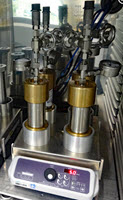
Juan completed his master’s in chemical and bioprocess engineering at the Technical University of Hamburg (TUHH). He was already working on his Ph.D. in chemistry there when his advisor Dr. Andreas Liese received GoMRI funding and offered him a graduate position researching biodegradation under high-pressure conditions. Juan accepted, thinking about how several past oil spills had significantly impacted the Spanish coastline’s flora and fauna. “One day we’ll have to turn to renewable energy, but right now humanity depends on crude oil,” said Juan. “I’m interested in what is going to happen in the crude oil industry once we reach a point where we can’t extract any more or have to do dangerous things like fracking to extract it. Many problems are arising from these more extreme methods, and I want to help understand all of this dynamic change.”
His Work
Oil-degrading microbes require oxygen to metabolize oil compounds. Juan and fellow C-IMAGE graduate students Steffen Hackbusch and Nuttapol Noirungsee combine microbes collected near the Deepwater Horizon site with oil and seawater inside high-pressure reactors that simulate conditions at 1,500 meters depth and 4° C. Juan observes the oxygen consumption of microbes and monitors their biodegradation process. When oxygen depletion, he assumes that the microbes have consumed all the oil that they can. Juan then uses gas chromatography mass spectrometry to analyze the reactor’s contents to determine the amount of oil that the microbes degraded.
Juan explained, “Imagine that you put in one drop of crude oil at the beginning of the process, and after one month the microorganisms have finished eating the oil. Well, the microbes don’t eat all of the oil – they only eat [certain compounds in it]. If you can determine how much of the oil has been consumed in that time period, you can predict what may happen to the crude oil in a realistic oil spill scenario.”

Juan is incorporating other variables, such as methane gas and Corexit dispersant, into his high-pressure experiments to learn how microbial oil degradation may change under different conditions. He also developed a high-pressure system that can be regulated to 4,000 m depth to test and compare possible differences in microbial degradation between 1,500 and 4,000 m. Juan’s experiments are ongoing, but he plans to develop prediction models based on his data that account for these biodegradation variables. “Before Deepwater Horizon, we didn’t know how quickly oil was going to degrade at high-pressure. Now, we have a hint,” said Juan. “With many other deep-water oil ventures planned for the future, I hope my research can help us estimate what percentage of oil would be degraded and to what extent if this or a similar accident happened again.”
His Learning
Juan listed teamwork, interdisciplinary collaboration, and knowledge sharing as the most important lessons he has learned through his GoMRI research. Being a member of a large consortium, he networked with scientists across many fields and learned the value of communication. “If we don’t share this knowledge, we aren’t going to grow as humans or as scientists,” said Juan. “The most important thing about science is you cannot hide a secret. We are discovering how nature works – communication is essential.” Dr. Liese commented that Juan reflects these values in the way he conducts his research, saying “Juan is a very open-minded person, who is always watching out to integrate [with our collaborative] partners.”

Juan also discussed how learning about the biological aspects of his work opened his eyes to a broader scope of his research. Trained in chemical engineering, Juan had a limited background in biology but was fascinated when he learned that certain microorganisms bloomed in the presence of oil because they were able to consume and degrade it. “I was used to taking Chemical A and Chemical B and a solvent and mixing them all together to get a result. I wasn’t really aware that those actions would cause organisms to do all of these really cool things. It was an exciting realization for me!”
His Future
Juan hopes to continue his research after graduation. Whether his scientific career is in industry or academia, he wants to continue pursuing what he calls the most exciting part of his career – crude oil research. He advises that students considering a scientific career follow a similar mindset. “Whatever it is that makes you happy, chase it. Don’t be convinced by society what an acceptable or more worthy career is. In the end, you’ll be happier and more successful doing something you love than doing something you think you ‘should’ be doing.”
The GoMRI community embraces bright and dedicated students like Juan Viamonte and their important contributions. The GoMRI Scholars Program recognizes graduate students whose work focuses on GoMRI-funded projects and builds community for the next generation of ocean science professionals. Visit the C-IMAGE website to learn more about their work.
By Stephanie Ellis and Maggie Dannreuther. Contact sellis@ngi.msstate.edu with questions or comments.
************
The Gulf of Mexico Research Initiative (GoMRI) is a 10-year independent research program established to study the effect, and the potential associated impact, of hydrocarbon releases on the environment and public health, as well as to develop improved spill mitigation, oil detection, characterization and remediation technologies. An independent and academic 20-member Research Board makes the funding and research direction decisions to ensure the intellectual quality, effectiveness and academic independence of the GoMRI research. All research data, findings and publications will be made publicly available. The program was established through a $500 million financial commitment from BP. For more information, visit https://gulfresearchinitiative.org/.
© Copyright 2010-2018 Gulf of Mexico Research Initiative (GoMRI) – All Rights Reserved. Redistribution is encouraged with acknowledgement to the Gulf of Mexico Research Initiative (GoMRI). Please credit images and/or videos as done in each article. Questions? Contact web-content editor Nilde “Maggie” Dannreuther, Northern Gulf Institute, Mississippi State University (maggied@ngi.msstate.edu).
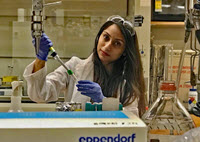
Petroleum hydrocarbons released by oil spills can accumulate on beaches and in nearshore sediments, potentially creating health risks for humans and coastal organisms. However, the highly variable conditions of beach environments make it difficult to determine the long-term behavior and fate of hydrocarbons in sands and sediment. Smruthi Karthikeyan combines bioinformatics and oil degradation data to examine microbial responses to oil in beach environments and identify populations that act as bioindicators of oil degradation and toxicity. Documenting microbial indicators and producing oil degradation models for environmental managers can help with future oil spill response plans for coastal zones.
Smruthi is a Ph.D. student with the Georgia Institute of Technology’s School of Civil and Environmental Engineering and a GoMRI Scholar with the project A Systems Approach to Improve Predictions of Biodegradation and Ecosystem Recovery in Coastal Marine Sediments Impacted by Oil Spill.
Her Path

Smruthi grew up in Chennai, India, near one of the largest beaches in the world, which sparked her interest in environmental health. Later, she completed an undergraduate chemical engineering program at Anna University because of its practical applications. She then transitioned to Columbia University for her master’s environmental engineering studies, which she considers an ideal interdisciplinary field that unites science and technology. “Being in the environmental engineering field gives me a lot of opportunities to view the environment from different perspectives,” she said.
Smruthi’s Ph.D. advisor Dr. Kostas Konstantinidis introduced her to the microbial world during one of his classes. She was intrigued about using bioinformatics to elicit information from such tiny creatures and was curious about the microbial role in environmental pollutant biodegradation. Konstantinidis received GoMRI funding in 2016 to research how microbes respond to oiling and identify indicator species for oil degradation and toxicity in beach sands. Accepting a position on his team made Smruthi excited about combining her love of environmental preservation with microbial genomics.
Her Work
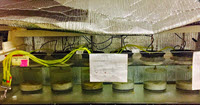
Smruthi conducts laboratory mesocosm experiments that mimic the in situ conditions found in the beach environment. She incubates Pensacola beach sand collected at different times during the Deepwater Horizon incident in six acrylic chambers (three with oiled sand and three with pristine sand) and replicates the tidal cycle by periodically adding and removing water overlying the sand. While sensors monitor pH, oxygen, nutrient, and temperature levels inside the chambers, she collects sand samples at designated time intervals and analyzes the microbial community’s DNA and RNA.
“Thanks to recent developments in cultivation-independent and next-generation sequencing methods, we are able to see microbial communities at a much higher resolution than ever before and identify their activities and nutrient limitations,” said Smruthi. “We can answer not only ‘Who is there?’ but also ‘What are they doing?’ from less than a gram of sand sample.”
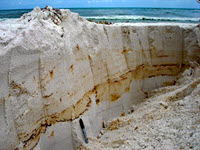
Smruthi’s analyses identify microbial populations with reduced abundance after oil exposure and observe if they return after oil is completely removed. Populations that do not return could warrant further investigation to assess how long it may take an ecosystem to recover after oiling. Her analyses also examine the gene content of individual microbial populations and compare them to hydrocarbons used in the experiment to determine which oil-degrading genes the microbes possess. A microbe that is more abundant after oil exposure may be a viable bioindicator of oil presence and biodegradation processes. Smruthi hopes that comparing her microbial data to the in situ sensor data can help develop an integrated conceptual model that allows predictions of pathways and oil degradation rates needed for future forecasts of recovery pathways.
Smruthi’s analyses have revealed a previously undiscovered microbial genus that was below detection in clean sands but rapidly increased to 30% of the total microbial community in oiled sands. According to publicly available databases, the species appears consistently in oil-contaminated sediments worldwide, particularly as a responder to other major oil spills, while being notably absent in unoiled environments. The microbe is metabolically versatile and can feast on oil and get the nitrogen it needs from the atmosphere, eliminating the need to add potentially harmful fertilizers that encourage microbial oil degradation. “It appears that this microbe belongs to a new genus of keystone oil degraders that has gone unnoticed so far and thus could represent a new model organism for oil bioremediation efforts,” said Smruthi. “We proposed to name this new bacterial genus “Macondimonas,” as we recovered it from the Macondo oil spill.”
Her Learning
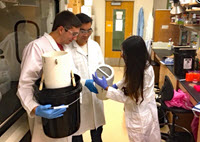
Smruthi’s experiences conducting GoMRI research opened her eyes to many different perspectives of oil spill research. Working with her advisor and their project’s principal investigator Dr. Markus Huettel helped her see the multifaceted aspects of her research, while interacting with scientists from different disciplines broadened her scientific perspective. “As someone who did not have a background in computational biology and marine ecology initially, this GoMRI grant has greatly helped my venture into this new and fascinating area,” she said. “It showed me that there’s a whole new realm out there filled with these microscopic marvels while at the same time integrating my engineering background.”
Her Future
Smruthi hopes to become a professor after completing her Ph.D. She encourages students considering a career in science and technology by telling them, “It is a rewarding and satisfying experience to actually see that your work can someday help the environment and society in whatever little way it can.”
Praise for Smruthi
Konstantinidis said that Smruthi is a hard worker with strong analytical abilities and a tremendous capacity and desire to learn new things. Her contributions helped his team explore new research ideas that resulted in important discoveries, such as the new oil-degrading bacteria. “[Our work with Smruthi] happened due to a bit of good luck,” he said. “When the advisor that Smruthi was working with initially decided to retire, I talked to Smruthi about the GoMRI project, and she got really excited and wanted to join our research team. It was good luck for all of us, I think!”
The GoMRI community embraces bright and dedicated students like Smruthi Karthikeyan and their important contributions. The GoMRI Scholars Program recognizes graduate students whose work focuses on GoMRI-funded projects and builds community for the next generation of ocean science professionals.
************
The Gulf of Mexico Research Initiative (GoMRI) is a 10-year independent research program established to study the effect, and the potential associated impact, of hydrocarbon releases on the environment and public health, as well as to develop improved spill mitigation, oil detection, characterization and remediation technologies. An independent and academic 20-member Research Board makes the funding and research direction decisions to ensure the intellectual quality, effectiveness and academic independence of the GoMRI research. All research data, findings and publications will be made publicly available. The program was established through a $500 million financial commitment from BP. For more information, visit https://gulfresearchinitiative.org/.
© Copyright 2010-2018 Gulf of Mexico Research Initiative (GoMRI) – All Rights Reserved. Redistribution is encouraged with acknowledgement to the Gulf of Mexico Research Initiative (GoMRI). Please credit images and/or videos as done in each article. Questions? Contact web-content editor Nilde “Maggie” Dannreuther, Northern Gulf Institute, Mississippi State University (maggied@ngi.msstate.edu).
The Sea Grant Oil Spill Outreach Team released a publication that explains the role that microbes play in using oil as an energy source and removing it from the environment.
The 8-page brochure Microbes and oil: What’s the connection? describes how these microscopic organisms can have a large-scale effect by quickly degrading oil in water and how different factors influence the rate that oil is broken down. It also describes how the microbes’ behavior can differ depending on their species, the type of oil they encounter, and the place they live in the marine environment. Included in the publication is what scientists are learning about how man-made response efforts such as chemical dispersants affect microbial oil degradation.
The Sea Grant Oil Spill Outreach Team synthesizes peer-reviewed science for a broad range of general audiences, particularly those who live and work across the Gulf Coast. Sea Grant offers oil-spill related public seminars across the United States.
Information about upcoming Sea Grant science seminars and recently-held events is available here. To receive email updates about seminars, publications, and the outreach team, click here.
************
GoMRI and the Sea Grant programs of the Gulf of Mexico (Florida, Mississippi-Alabama, Louisiana, and Texas) have partnered to create an oil spill science outreach program.
The Gulf of Mexico Research Initiative (GoMRI) is a 10-year independent research program established to study the effect, and the potential associated impact, of hydrocarbon releases on the environment and public health, as well as to develop improved spill mitigation, oil detection, characterization and remediation technologies. An independent and academic 20-member Research Board makes the funding and research direction decisions to ensure the intellectual quality, effectiveness and academic independence of the GoMRI research. All research data, findings and publications will be made publicly available. The program was established through a $500 million financial commitment from BP. For more information, visit https://gulfresearchinitiative.org/.
© Copyright 2010- 2018 Gulf of Mexico Research Initiative (GoMRI) – All Rights Reserved. Redistribution is encouraged with acknowledgement to the Gulf of Mexico Research Initiative (GoMRI). Please credit images and/or videos as done in each article. Questions? Contact web-content editor Nilde “Maggie” Dannreuther, Northern Gulf Institute, Mississippi State University (maggied@ngi.msstate.edu).

Natural seeps are abundant in the Gulf of Mexico and help create a chemically unique habitat where microbial populations can flourish. Andy Montgomery is researching the relationship between marine microbes and ocean chemistry and how chemical shifts affect the role microorganisms play in biogeochemical cycling, a common pathway for chemicals and organic matter to move through the ocean. His goal is to push the microbes to their limits to determine what they are capable of under extremely stressful conditions to understand how major chemical disturbances, such as oil spills, affect microbial populations and processes.
Andy is a Ph.D. student with the University of Georgia’s Department of Marine Sciences and a GoMRI Scholar with the Ecosystem Impacts of Oil and Gas Inputs to the Gulf-2 (ECOGIG-2) consortium.
His Path
Andy’s grandfathers inspired his love for life and science when he was a child. One grandfather, who lives on a lake, taught him that life is like fishing: the more lines you have in the water, the more adventures you will enjoy. His other grandfather, a biology professor, taught him to appreciate life’s ever-changing forms. These lessons instilled in Andy a desire to understand how life’s components are intertwined and inspired a passion to expand his mind through science and life experiences.
Andy began his graduate career in the University of Georgia’s Integrative Life Science program, an interdisciplinary program that covers many disciplines, including marine sciences, infectious diseases, and biochemistry. The program allowed Andy to experience different labs on campus while he searched for a research focus. While working with Dr. Mandy Joye, her research about environmental influences on marine microbes fascinated him and he wanted to take part in that opportunity. While working in a non-GoMRI position in Joye’s lab, Andy was asked to fill in for an ill researcher aboard an ECOGIG research cruise.
“It was my first chance to go out to sea, and I immediately fell in love with it,” said Andy. “We spent a month on the R/V Endeavor collecting samples in the Gulf of Mexico. I got to see firsthand how amazingly beautiful and fragile our oceans are. With my newfound enthusiasm for going out to sea and working in the Gulf, Mandy and I agreed that ECOGIG research would be a perfect fit for my graduate work.”
His Work
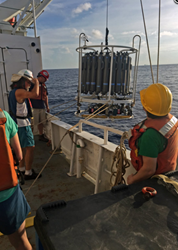
Andy investigates microbes’ response to chemical changes in their environment from two angles. First, he wants to understand how the microbial population responds to major environmental shifts such as oil spills and how the population changes over time after its initial response. He is particularly interested in determining if microbial populations return to pre-event levels or if they experience permanent changes. Second, he wants to determine how microbial processes related to carbon cycling react to environmental changes.
Andy collects Gulf water samples and immediately measures the rates of certain microbial processes (such as carbon degradation or assimilation) to establish their baseline activity. He then supplements the samples with a certain chemical compound, such as methane, oil, or nutrients, that he hypothesizes will affect the organisms. He measures changes in the rates of the microbial processes relative to baseline observations and analyzes genomic data using stable isotope probing and next-generation sequencing. These observations help him determine which microbial populations the chemicals are enriching or inhibiting and if and how microbial processes are altered. His uses these findings to better understand how these microbes may react to similar exposures in the natural environment.
“After the spill, there was a major increase in carbon uptake and usage because organic matter containing carbon was readily available to microorganisms,” explained Andy. “Understanding which geochemical factors control these processes, how that correlates to the microbial population, and how the population changes over time will help us prepare for future oil spills and other disasters.”
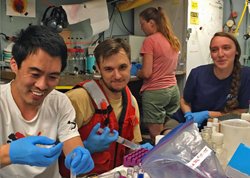
His Learning
Andy’s experiences working in Joye’s lab have helped him understand how important passion is to scientific research. The lab members’ contagious excitement and desire to learn and educate others about the natural world inspire him to give back to society. “The fervor exhibited through their work is unmistakable, and they never stop working to better understand the world we live in,” explained Andy. “I hope this feeling continues to grow and that I am able to leave a positive lasting impact on this Earth through my career.”
His Future
Andy discovered the importance of educating society on scientific issues through teaching undergraduate labs and participating in ECOGIG outreach events such as the Ocean Discovery Zone and Science at the Stadium. He hopes to create future exciting opportunities for others to learn about emerging scientific ideas and findings.
He tells students considering a scientific career to get involved as early and often as they can. “I had the opportunity to do research my freshman year of college. I got hands-on experience from day one and learned a lot of basic lab techniques early on, which greatly helped me advance my skills and knowledge,” he said. “Even if you can’t immediately join a lab, there are many university research courses, citizen science opportunities, or outreach programs to get involved in.”
Praise for Andy
Joye said that during his time in her lab, Andy grew into a thoughtful, meticulous scientist and a passionate and dedicated instructor. She described him as a natural leader with outstanding character, “Andy sets an exceptional example and works tirelessly on his own projects while always being available to give others a hand as needed. He works to not only meet but also exceed expectations and holds himself to a high standard. It is such a pleasure and honor to mentor someone like Andy.”
The GoMRI community embraces bright and dedicated students like Andy Montgomery and their important contributions. The GoMRI Scholars Program recognizes graduate students whose work focuses on GoMRI-funded projects and builds community for the next generation of ocean science professionals. Visit the ECOGIG website to learn more about their work.
************
The Gulf of Mexico Research Initiative (GoMRI) is a 10-year independent research program established to study the effect, and the potential associated impact, of hydrocarbon releases on the environment and public health, as well as to develop improved spill mitigation, oil detection, characterization and remediation technologies. An independent and academic 20-member Research Board makes the funding and research direction decisions to ensure the intellectual quality, effectiveness and academic independence of the GoMRI research. All research data, findings and publications will be made publicly available. The program was established through a $500 million financial commitment from BP. For more information, visit https://gulfresearchinitiative.org/.
© Copyright 2010-2018 Gulf of Mexico Research Initiative (GoMRI) – All Rights Reserved. Redistribution is encouraged with acknowledgement to the Gulf of Mexico Research Initiative (GoMRI). Please credit images and/or videos as done in each article. Questions? Contact web-content editor Nilde “Maggie” Dannreuther, Northern Gulf Institute, Mississippi State University (maggied@ngi.msstate.edu).
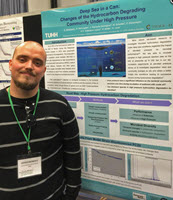
The Deepwater Horizon incident occurred at 1500 m depth, where the pressure is approximately 15 MPa, but little is known about how such high pressure affects the metabolic processes involved with oil biodegradation for bacteria that live there. Steffen Hackbusch conducts laboratory experiments that incubate microbes collected from deep-sea Gulf of Mexico sediment in seawater treated with oil and dispersant in high-pressure reactors mimicking deep-sea conditions. His observations of how the microbes react under high-pressure conditions will help inform future oil spill response as decision makers consider biodegradation at depth as they develop remediation strategies.
Steffen is a microbiology Ph.D. student at the Hamburg University of Technology’s Institute of Technical Biocatalysis and a GoMRI Scholar with the Center for the Integrated Modeling and Analysis of Gulf Ecosystems II (C-IMAGE II).
His Path
Steffen’s interest in science started with having two brothers, “As physical fights became an outdated way to prove who was right, we started using logical arguments and reasoning – and still do over the holidays!” As a high school student, he was fascinated by history and physics and wondered if he could become well-educated simply by reading enough. When he realized that science often identifies as many questions as it does answers, he was hooked.

Steffen initially studied engineering as an undergraduate at the University of Duisburg-Essen hoping to answer questions about how things work. He later changed his degree to water science (a degree path involving biochemistry with a focus on water) after his father, a physics teacher, inspired questions about why things work. While working towards a master’s degree in evolution, ecology, and systematics at Friedrich Schiller University Jena, Steffen attended lectures by Dr. Kirsten Küsel and Dr. Hans-Curt Flemming that sparked his interest in microbial evolution. Following his master’s research, Steffen began his Ph.D. studies at Hamburg University of Technology with Dr. Rudolf Müller and Dr. Andreas Liese, who were searching for a microbiologist to help their team investigate the dynamics of oil fate under deep-sea conditions.
“I enjoy contributing to the scientific process of accumulating knowledge that helps protect the world humans live in, especially the deep sea which is a huge part of our ecosystem that we know little about,” said Steffen.
His Work
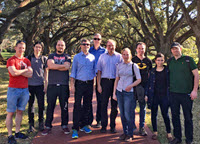
Steffen puts oil-degrading microbes that were collected near the Deepwater Horizon site into high-pressure reactors that simulate deep-sea conditions to observe how they are affected by different pressures. His trials expose microbes to 10 and 15 MPa pressure with 1% v/v of oil (a concentration that caused degradation/growth effects in previous experiments) and dispersant concentrations similar to what was applied at depth during the spill.
Steffen incubates a single oil-degrading species in a reactor tube to see how it deals with pressure alone and then with combinations of pressure and the presence of oil and dispersant. He measures growth and estimates the number of viable bacteria cells after exposure. He repeats the experiment using entire microbial communities collected from upper layers of seafloor sediment near the spill site. Using next-generation sequencing on microbes after exposure treatments, Steffen identifies relative increases and decreases in microbial abundance under different conditions.
Steffen explained that by assessing single species and whole communities, researchers can acquire two perspectives about exposure: an ecological view of how an ecosystem may react and a close-up view of the molecular processes involved with a single species. So far, he observed various microbial responses, with some species experiencing difficulty growing and consuming oil at elevated pressure while others appeared unaffected. Though his exposure trials are still on-going, early results suggest that dispersant may have greater impacts on microbial community structure compared to oil and pressure.
“We hope to contribute to the overall picture dealing with future oil spills by stressing that pressure has to be considered in the microbial degradation of crude oil,” said Steffen. “There are several studies from fellow GoMRI members addressing pressure as a factor that influences bacterial communities, and our research is able to contribute to that discussion.”
His Learning
Working in Dr. Liese’s lab, Steffen learned the importance of team work and was able to view and approach his research from new angles through conversations with his colleagues, particularly fellow graduate student Nuttapol Noirungsee. Collaborating with other researchers and learning about their findings at the annual Gulf of Mexico Oil Spill and Ecosystem Science Conference was a particularly striking experience for Steffen. “Seeing so many bright minds working towards one goal had a lasting impression on me,” he said. “I particularly enjoyed working in an international consortium, where you can meet people from around the world sharing ideas and passions.”
His Future
After defending his thesis, Steffen hopes to continue his journey answering scientific questions and pursuing new challenges and opportunities.
Praise for Steffen
Dr. Liese describes Steffen as a highly motivated scientist with a burning desire to help elucidate the effects of pressure and Corexit dispersant on deep-sea microbes. “Steffen is very eager to teach himself and learn new methods that support his research,” said Dr. Liese. “I am very happy that he is a member of our interdisciplinary team as a microbiologist.”
The GoMRI community embraces bright and dedicated students like Steffen Hackbusch and their important contributions. The GoMRI Scholars Program recognizes graduate students whose work focuses on GoMRI-funded projects and builds community for the next generation of ocean science professionals. Visit the C-IMAGE website to learn more about their work.
By Stephanie Ellis and Nilde Maggie Dannreuther. Contact sellis@ngi.msstate.edu for questions or comments.
************
The Gulf of Mexico Research Initiative (GoMRI) is a 10-year independent research program established to study the effect, and the potential associated impact, of hydrocarbon releases on the environment and public health, as well as to develop improved spill mitigation, oil detection, characterization and remediation technologies. An independent and academic 20-member Research Board makes the funding and research direction decisions to ensure the intellectual quality, effectiveness and academic independence of the GoMRI research. All research data, findings and publications will be made publicly available. The program was established through a $500 million financial commitment from BP. For more information, visit https://gulfresearchinitiative.org/.
© Copyright 2010-2019 Gulf of Mexico Research Initiative (GoMRI) – All Rights Reserved. Redistribution is encouraged with acknowledgement to the Gulf of Mexico Research Initiative (GoMRI). Please credit images and/or videos as done in each article. Questions? Contact web-content editor Nilde “Maggie” Dannreuther, Northern Gulf Institute, Mississippi State University (maggied@ngi.msstate.edu).
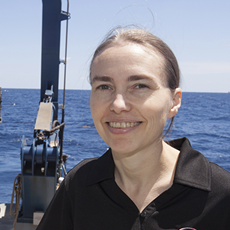 Dr. Mandy Joye recently appeared on the show to discuss her research on the ocean’s microbial “worker bees,” which carry out critical processes that keep the ocean healthy, and their reaction to the Deepwater Horizon oil spill.
Dr. Mandy Joye recently appeared on the show to discuss her research on the ocean’s microbial “worker bees,” which carry out critical processes that keep the ocean healthy, and their reaction to the Deepwater Horizon oil spill.
The Role of Microbial Motility for Degradation of Dispersed Oil project is lead by P.I. Jacinta C. Conrad, University of Houston.
Microbial biodegradation processes are thought to have played a substantial role in the surprisingly swift disappearance of oil and gas released into the Gulf of Mexico after the catastrophic Deepwater Horizon MC252 blowout. Although previous GoMRI-supported work investigated the composition of the coastal, open-open, and deepwater microbial communities that degraded this oil, much remains poorly understood regarding the impact of physical factors in heterogeneous ocean and coastal environments on the rate of microbial biodegradation. Hence there is a pressing yet unmet need to understand how (a) nearby liquid oil/liquid water or gaseous oil/liquid water interfaces, (b) fluid flow, and (c) dispersants affect microbial motility towards dispersed oil. Moreover, this need must be addressed for bacteria living in each type of ecosystem impacted by catastrophic oil spills. The objective of this project is to elucidate the effects of oil-water interfaces on motility of marine bacteria in the initial stage in biodegradation, as microbes move towards and attach to dispersed oil.
Click for access to GoMRI’s YouTube videos of RFP-V Projects…
************
This project was funded by the Gulf of Mexico Research Initiative (GoMRI) in the RFP-V funding program.
The Gulf of Mexico Research Initiative (GoMRI) is a 10-year independent research program established to study the effect, and the potential associated impact, of hydrocarbon releases on the environment and public health, as well as to develop improved spill mitigation, oil detection, characterization and remediation technologies. An independent and academic 20-member Research Board makes the funding and research direction decisions to ensure the intellectual quality, effectiveness and academic independence of the GoMRI research. All research data, findings and publications will be made publicly available. The program was established through a $500 million financial commitment from BP. For more information, visit http://gulfresearchinitiative.org/.

Cover of the September 2016 Oceanography Magazine, Volume 29, Number 3
7th year of the largest coordinated research endeavor around an ocean event.
The 2010 Deepwater Horizon oil spill and subsequent response efforts raised concerns about impacts on the Gulf of Mexico’s ocean and coastal environments. The Gulf of Mexico Research Initiative (GoMRI), in response to the spill, initiated an unprecedented 10-year scientific research program funded by BP. Seven years into the program, we know more than ever before about the Gulf’s complex environment, dynamic processes, and response to stressors.
Oceanography magazine dedicated a special issue to this research, GoMRI: Deepwater Horizon Oil Spill and Ecosystem Science, and below are highlights from 13 papers it featured.*
WHERE OIL WENT
Surface oil covered a cumulative area of 149,000 km2 in the northeastern Gulf. Wind and currents transported surface slicks towards land, affecting approximately 1,800-2,100 km of shoreline, a third of which were moderately to heavily oiled including 1,075 km in Louisiana. Macondo oil was visually evident at the edge of Louisiana marshes and up to 10 m inland.
Subsea oil and gas rose through the water column and formed an underwater oil plume that covered an area of approximately 930 km2 and made direct contact with continental slope sediments. A significant proportion of surface oil returned to the deep seafloor primarily through an extensive marine oil snow sedimentation event known as a “dirty blizzard,” forming a 0.5-1.2 cm thick floc layer.
Cleanup efforts removed oil from 73% of beaches affected by the spill, but residual oil remained as surface residue balls (SRBs), submerged oil mats, and in marsh plants and sediment, and is subject to continued weathering, biodegradation, and possible resuspension.
HOW OIL CHANGED
Crude oils contain thousands of compounds that, upon entering a marine environment, undergo significant compositional changes from weathering processes such as evaporation, dissolution, emulsification, dispersion, sedimentation/flocculation, microbial degradation, and photooxidation.
Most crude oil compounds are readily biodegradable and generally follow a clear degradation pattern: n-alkanes first followed by branched alkanes, lower molecular weight aromatics, higher molecular weight aromatics, and cyclic alkanes. Anaerobic biodegradation is a slower process than aerobic degradation, and crude oil compounds can remain relatively unaltered in reduced sediments and environments for long time periods and may appear as relatively fresh oil compared to surface oil exposed to aerobic conditions.
MICROBIAL RESPONSE AFFECTING OIL FATE
Macondo oil had a relatively low content of persistent resins and asphaltenes, and warm temperatures supported geochemical and biological degradation. The prevalence of oil-degrading bacteria generated a prompt response from the microbial community and subsequent biodegradation. Microbial communities in the plume were different from those in non-plume waters and exhibited a significant enrichment of hydrocarbon-degrading metabolic genes. Aerobic oxidation of short chain alkanes, propane, and butane caused up to 70% of oxygen depletion observed in the oil plume.
Residual oil trapped in Pensacola Beach sands showed a progression of microbial populations linked to hydrocarbon degradation. Early-responder microbes were followed by populations capable of aromatic hydrocarbon decomposition. Microbial abundance in oiled sands was 10-10,000 times that in clean sands in the first four months after oil came ashore. A typical beach-environment microbial community returned after one year but differed significantly from pre-spill communities.
DEEP OCEAN IMPACTS
Carbon from the spill was likely incorporated into the mesopelagic (200-1,000 m depth) food web through consumption of prey rich in depleted carbon. The nature of microbial communities in the deep sea likely changed. An 80-93% decline in benthic foraminifera was related to reducing conditions and increased polycyclic aromatic hydrocarbons (PAH) concentrations.
Deepsea megafauna had lower diversity and abundance near the spill site relative to regions farther away, though blue marlin, Atlantic sailfish, blackfin tuna, and dolphinfish showed no significant reduction in larval abundance. Bottom-dwelling golden tilefish had the highest concentrations of naphthalene metabolite levels in bile measured in fishes globally. Tunas and jacks collected near the spill site exhibited developmental crude oil cardiotoxicity, suggesting a possible loss of early predator recruits that spawn in open waters. Sperm whale acoustic activity decreased near the spill site by a factor of two and increased farther away, suggesting they relocated.
Hard-bottom communities, including natural and artificial reefs, suffered injuries that were severe and long-lasting. Macrofauna and meiofauna diversity had not recovered after four years, and community structure differences still persist. Deep-sea colonial corals, in particular octocorals near the spill site, showed visible evidence of impact, and flocculent material covering the coral contained chemical fingerprints associated with Macondo oil and DOSS (dioctyl sodium sulfosuccinate). Researchers returned to these coral eight times and observed continued impacts such as tissue death with some coral skeletons secondarily colonized by hydrozoans.
Field measurements showed that planktonic community abundance and species composition returned to pre-spill conditions within a year. Laboratory experiments indicated that zooplankton exposed to sublethal crude oil levels bioaccumulated five PAHs, which could increase their susceptibility to predation and enhance trophic transfer of toxic PAHs.
MARSH IMPACTS
There were immediate negative impacts in moderately to heavily oiled marshes in southeastern Louisiana. The average concentration of total alkanes and PAHs in June 2013 was 20 and 374 times pre-oiled conditions, respectively. Total alkane concentrations were on a trajectory to be near baseline levels by 2015, but this did not occur likely a result of multiple resuspension events from storms.
Some damaged marsh shorelines showed precipitous shoreline erosion at least 2.5 years after oiling due to damaged root systems. Marshes lost due to oiling and shoreline erosion will not return without human intervention. Forty-two months after the spill, heavily oiled marshes showed near-complete plant mortality, and live aboveground biomass was 50% of reference marshes. Decreased living marsh vegetation and population levels of some fauna were obvious for 2-5 years. Meiofauna density was lower along with S. alterniflora grasses in heavily oiled areas.
Fiddler crab average size declined and there were proportion shifts in two species composition. Periwinkle snails density declined, and a slow recovery in abundance and size distribution was related to habitat recovery. Worms, seed shrimp, and mud dragons had not recovered to background levels 48 months post-spill. Killifish showed little evidence of spill impacts. Horse fly abundance declined sharply. Arthropods were suppressed by 50% in 2010 but had largely recovered in 2011. Seaside Sparrow nests on unoiled sites were more likely to fledge than those on oiled sites. Loons varied in frequency with PAHs by year and exhibited reduced body mass as PAH concentrations increased.
These effects are expected to continue – possibly for decades – to some degree, or the marsh ecosystem will reach a new baseline condition in heavily damaged areas.
FISH & SEAFOOD IMPACTS
Commercial, recreational, and subsistence fisheries were closed in fall 2010 in areas where oil was observed and predicted to travel and reopened by April 2011. Impacts on fisheries productivity were relatively short-lived, with landings and their values returning to pre-spill levels or greater for most fishery species. However, long-term effects are yet to be determined. Laboratory studies indicate that early life stages of fish are generally more sensitive to oil and dispersant’s sublethal effects (with some resulting in reduced swimming performance and cardiac function) than adults.
Public health risks from exposure to crude oil residue through seafood or coastal beaches returned to pre-spill levels after the spill dissipated. Seafood from reopened areas was found to be safe for consumption, with PAH levels comparable to those found in common local processed foods. PAH concentrations detected in many seafood samples during and following the spill were at least 2 orders of magnitude below levels of public health concern. DOSS was detected in less than 1% of samples and at levels below public health concern.
Tests on SRBs showed that Vibrio vulnificus were 10 times higher than the surrounding sand and up to 100 times higher than seawater, suggesting that SRBs can act as reservoirs for bacteria including human pathogens. Coquina clams initially showed higher PAH levels relative to the surrounding sand, but levels decreased continuously and were undetectable in sand (one year) and Coquina tissues (two years).
DISPERSANT EFFECTS & FUTURE TECHNOLOGIES
Dispersant increased the oil fraction that spread within the water column and laterally displaced oil that reached the sea surface. Dispersants reduced droplet sizes and rise velocities, resulting in a more than tenfold increase in the downstream length of the surface oil footprint.
Chemical dispersants may be more toxic to some marine organisms than previously thought, and small oil droplets created by dispersant use and directly consumed by marine organisms are often more toxic than crude oil alone. Dispersant effects on microorganisms might be taxa-specific, and some studies suggest that dispersants stimulated biodegradation while others conclude the opposite. Degradation rates of hexadecane and naphthalene were more rapid in the absence of dispersants, as was the overall removal of the water-accommodated oil fraction.
Dispersant applied at the broken riser pipe helped form a deep water oil plume. DOSS was likely transferred to the plume and was later detected in surface sediments, on corals, and within oil-sand patties.
A future option is development of plant-based materials for efficient chemical herding of compact oil slicks into layers that are sufficiently thick to enable oil burning or skimming. Opportunities exist for new dispersants that work in synergy with current dispersants and mitigate some of their disadvantages. Examples include a system containing soybean lecithin and the surfactant Tween 80, substitution of lecithin for DOSS, and using carbon-based particles and silicas to stabilize emulsified droplets. Laboratory research needs to be conducted at concentrations and under conditions relevant to marine environments.
MODELING CAPABILITIES
Model improvements provide a better understanding of droplet formation in the turbulent plume above the wellhead. No model during the spill could predict droplet size distribution, which dictates rise times, dissolution, and biodegradation. Oil spill models now include the ability to simulate the rise of a buoyant oil plume from the seabed to the surface. Consideration of oil’s 3D movement permits the prediction of oil spreading through subsurface plumes. Our understanding of the near-surface oceanic layer and atmospheric boundary layer, including the influences of waves and wind, has also improved.
Oil spill modeling routines will likely be included in Earth system models, linking physical models with marine sediment and biogeochemical components. Advances in coupled nearfield-farfield dynamic modeling together with real-time, seven-day circulation forecasts allow for near-real-time tracking and forecasting of oil dynamics. This is the most promising approach for rapid evaluation of blowout predictions to support first response decisions.
* Overton, E.B., T.L. Wade, J.R. Radović, B.M. Meyer, M.S. Miles, and S.R. Larter. 2016. Chemical composition of Macondo and other crude oils and compositional alterations during oil spills. Oceanography 29(3):50–63
Socolofsky, S.A., E.E. Adams, C.B. Paris, and D. Yang. 2016. How do oil, gas, and water interact near a subsea blowout? Oceanography 29(3):64–75
Passow, U., and R.D. Hetland. 2016. What happened to all of the oil? Oceanography 29(3):88–95
Özgökmen, T.M., E.P. Chassignet, C.N. Dawson, D. Dukhovskoy, G. Jacobs, J. Ledwell, O. Garcia-Pineda, I.R. MacDonald, S.L. Morey, M.J. Olascoaga, A.C. Poje, M. Reed, and J. Skancke. 2016. Over what area did the oil and gas spread during the 2010 Deepwater Horizon oil spill? Oceanography 29(3):96–107
John, V., C. Arnosti, J. Field, E. Kujawinski, and A. McCormick. 2016. The role of dispersants in oil spill remediation: Fundamental concepts, rationale for use, fate, and transport issues. Oceanography 29(3):108–117
Passow, U., and K. Ziervogel. 2016. Marine snow sedimented oil released during the Deepwater Horizon spill. Oceanography 29(3):118–125
Tarr, M.A., P. Zito, E.B. Overton, G.M. Olson, P.L. Adhikari, and C.M. Reddy. 2016. Weathering of oil spilled in the marine environment. Oceanography 29(3):126–135
Joye, S.B., S. Kleindienst, J.A. Gilbert, K.M. Handley, P. Weisenhorn, W.A. Overholt, and J.E. Kostka. 2016. Responses of microbial communities to hydrocarbon exposures. Oceanography 29(3):136–149
Rabalais, N.N., and R.E. Turner. 2016. Effects of the Deepwater Horizon oil spill on coastal marshes and associated organisms. Oceanography 29(3):150–159
Murawski, S.A., J.W. Fleeger, W.F. Patterson III, C. Hu, K. Daly, I. Romero, and G.A. Toro-Farmer. 2016. How did the Deepwater Horizon oil spill affect coastal and continental shelf ecosystems of the Gulf of Mexico? Oceanography 29(3):160–173
Buskey, E.J., H.K. White, and A.J. Esbaugh. 2016. Impact of oil spills on marine life in the Gulf of Mexico: Effects on plankton, nekton, and deep-sea benthos. Oceanography 29(3):174–181
Fisher, C.R., P.A. Montagna, and T.T. Sutton. 2016. How did the Deepwater Horizon oil spill impact deep-sea ecosystems? Oceanography 29(3):182–195
Dickey, R., and M. Huettel. 2016. Seafood and beach safety in the aftermath of the Deepwater Horizon oil spill. Oceanography 29(3):196–203
************
The Gulf of Mexico Research Initiative (GoMRI) is a 10-year independent research program established to study the effect, and the potential associated impact, of hydrocarbon releases on the environment and public health, as well as to develop improved spill mitigation, oil detection, characterization and remediation technologies. An independent and academic 20-member Research Board makes the funding and research direction decisions to ensure the intellectual quality, effectiveness and academic independence of the GoMRI research. All research data, findings and publications will be made publicly available. The program was established through a $500 million financial commitment from BP. For more information, visit http://gulfresearchinitiative.org/.
© Copyright 2010- 2017 Gulf of Mexico Research Initiative (GoMRI) – All Rights Reserved. Redistribution is encouraged with acknowledgement to the Gulf of Mexico Research Initiative (GoMRI). Please credit images and/or videos as done in each article. Questions? Contact web-content editor Nilde “Maggie” Dannreuther, Northern Gulf Institute, Mississippi State University (maggied@ngi.msstate.edu).
The The State-of-the-Art Unraveling of the Biotic and Abiotic Chemical Evolution of Macondo Oil: 2010-2018 project is lead by Ryan P. Rodgers, Florida State University.

Researcher Ryan P. Rodgers
Once released into the environment, petroleum undergoes physical processes that modify its native composition (water washing and evaporative losses) and chemical processes (largely oxidative, i.e. photo-oxidation and biodegradation) that we and others have shown results in an increase in oxygen-containing chemical functionalities of the predominately hydrocarbon matrix to ketone, hydroxyl, and carboxylic acid functionalities. Efforts to date have documented these weathering trends for Macondo well oil (MWO) from approx. 10 months post-spill to the present. It has been demonstrated that a pool of persistent oxidized petroleum-derived material increased with increasing weathering of MWO in the environment. However, not much is yet known about the molecular structure of the oxygenated transformation products, its environmental fate, or potential effects, as these oxidized products lie largely outside the conventional gas chromatography analytical window. However, there now exists technology to quantitatively track how the various oil-weathering processes (evaporative, water washing, photo-oxidation and biodegradation) change the petroleum composition at a molecular level. For example, it has been demonstrated that ultra-high resolution mass spectrometric analysis allows identification of 1000’s of oxidative weathering products.
This project aims to apply these techniques in order to understand how these weathering processes occur, to quantify rate(s) of oxygenated oil weathering product formation and degradation, and characterize toxicological effects on the ecosystem. More specifically, this project aims to answer the questions: (1) How does the molecular composition of MWO oil change over time? (2) Which compositional changes are caused by photo-oxidation? Biodegradation? How does the structural / chemical composition of the oil influence oxidation? (3) How does this compositional change influence toxicity of weathered MWO? (4) What is the overall fate of MWO on a time scale of 8 years?
This project will track the continued weathering of MWO and focus on early sampling dates (0-10 months) immediately after the spill, where a rapid formation of oxygenated products is hypothesized, as well as highly weathered samples (to be collected up to eight years after the spill). The proposed analytical methodologies will capture bulk and molecular level, biotic / abiotic temporal compositional changes in the MWO as it weathers in the environment. The efforts will generate a compositional database of the quantitative and qualitative weathering of MWO. Second, analysis of field samples will be combined with controlled laboratory experiments of MWO photo-oxidation and biodegradation. Third, MWO and other oils, their structurally defined fractions, and all weathering products for each, will be screened for toxicity (narcosis), and observed effects will be linked (correlated) to the molecular compositional change in MWO during weathering. Finally, since the structural dependence of weathering will captured herein, along with each fractions toxicity (and water soluble fractions), a simple model will be constructed based on the quantitative yields of each structural fraction, its associated weathering products, and rate of formation. Thus, simple quantitative fractionation of any future contaminant could potentially be used to predict the rate, mass, and type of weathering products formed. The model will be validated against field data collected from the Deepwater Horizon disaster and other recent oil spills.
Click for access to GoMRI’s YouTube videos of RFP-V Projects…
************
This project was funded by the Gulf of Mexico Research Initiative (GoMRI) in the RFP-V funding program.
The Gulf of Mexico Research Initiative (GoMRI) is a 10-year independent research program established to study the effect, and the potential associated impact, of hydrocarbon releases on the environment and public health, as well as to develop improved spill mitigation, oil detection, characterization and remediation technologies. An independent and academic 20-member Research Board makes the funding and research direction decisions to ensure the intellectual quality, effectiveness and academic independence of the GoMRI research. All research data, findings and publications will be made publicly available. The program was established through a $500 million financial commitment from BP. For more information, visit http://gulfresearchinitiative.org/.
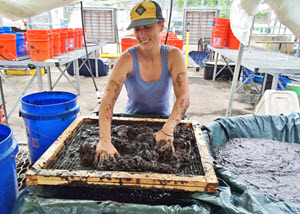
Postdoc Brittany Bernik strains marsh mud through a screen to prepare it for greenhouse experiments at Tulane University. (Photo by Sunshine Van Bael)
Living inside the roots and leaf tissues of marsh grass are bacteria and fungi known as endophytes that help promote plant growth. Since some endophytes can also help degrade petroleum that the plants absorb, it is possible they could be a natural tool to help clean up oil buried in marsh soils.
The Gulf of Mexico Research Initiative (GoMRI) recently awarded Dr. Sunshine Van Bael a grant to explore plant-bacterial symbioses as they relate to petroleum and dispersant pollution in coastal salt marshes. Her team is investigating how endophyte communities inside oiled coastal plants incorporate and amplify oil-degrading bacteria and if plants can deliver endophytic bacteria to polluted soils, hastening petroleum biodegradation. The team will use their findings to learn how plant-bacterial combinations may be used to quickly and safely restore oiled marshes.
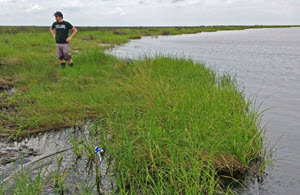
Ph.D. student Stephen Formel helps collect soil at Bay Jimmy in Barataria Bay. (Photo by Brittany Bernik)
Preliminary research suggests that when coastal grasses are contaminated with petroleum, the bacterial communities in their tissues incorporate more taxa with petroleum tolerance and biodegradation capabilities. However, these processes are not well characterized. Improving our understanding about the mechanisms driving how grasses, symbiotic bacteria, and polluted soil interact could lead to the development of tools that use plant-delivered, naturally occurring bacteria to clean up polluted soils.
The team is conducting field work and controlled greenhouse experiments to identify how bacteria and bacterial communities behave in oiled and unoiled sites and determine how quickly the oil in soil and plant tissues are broken down. Next, they will investigate the bacteria’s interactions with oil droplets and oxygen and see if plant roots can deliver oxygen and bacteria to oil buried in the marsh soil.

The greenhouse experiment at Tulane University was set up in June 2016 to test how plants and their symbionts work together to clean up oil. (Photo by Stephen Formel)
“We know a lot about how bacteria break down oil in the ocean and on the beach, but we haven’t really investigated if and how this happens inside of the plant,” said Van Bael. “We hope to learn how plants and their microbial symbionts can influence oil spill clean-up, especially the possibility that the best tool to help clean up oil in buried marsh soils faster is plant-bacterial combinations.”
The project’s researchers are Sunshine Van Bael, Kyriakos D. Papadopoulos, Michael Blum, and Lisa Fauci of Tulane University, Claudia Gunsch of Duke University, and John Pardue of Louisiana State University. Their project is Chemical Evolution and Plant-Microbe Degradation of Petroleum in Saline Marsh Plants and Soils.
************
The Gulf of Mexico Research Initiative (GoMRI) is a 10-year independent research program established to study the effect, and the potential associated impact, of hydrocarbon releases on the environment and public health, as well as to develop improved spill mitigation, oil detection, characterization and remediation technologies. An independent and academic 20-member Research Board makes the funding and research direction decisions to ensure the intellectual quality, effectiveness and academic independence of the GoMRI research. All research data, findings and publications will be made publicly available. The program was established through a $500 million financial commitment from BP. For more information, visit http://gulfresearchinitiative.org/.
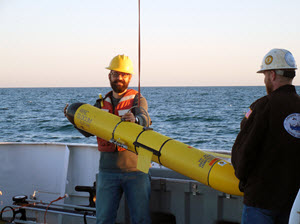
Adam Boyette retrieves a glider on the deck of the R/V Point Sur, where he served as chief scientist on the three-day cruise examining the impacts of the Bonnet Carré spillway opening. (Photo by Alison Deary)
Microscopic organisms called plankton, an important component of the marine food web, congregate in the freshwater-laden coastal waters of the northern Gulf of Mexico. Adam Boyette wants to learn more about how and where these plankton live to better understand how an oil spill or other disaster might impact their populations.
He is collaborating with other scientists to show how the near-coastal environment interconnects with the larger world around it.
Adam is a GoMRI Scholar with CONCORDE working towards a Ph.D. in marine science at the University of Southern Mississippi (USM). He discusses his journey from the Mississippi Delta to the coastal Gulf he now calls home.
His Path
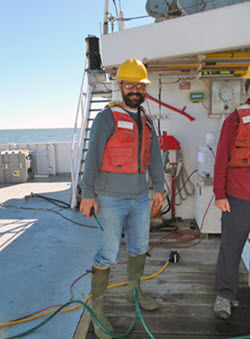
Adam stands by on the deck of the R/V Point Sur to retrieve the CTD rosette. (Photo by Alison Deary)
Adam grew up in a rural town at the heart of the Mississippi Delta, an area made famous by Muppets-creator Jim Henson and blues music. He spent his childhood outdoors collecting insects and snakes, fishing, and exploring the Delta’s rich ecology.
His first visit to the Florida panhandle at age eight sparked a life-long love of the ocean that would eventually steer his future.
Adam did not begin college immediately after high school. Instead, he worked on Mississippi River tow boats and in catering kitchens, discovering new interests and skills in every job. He would earn a bachelor’s degree in marine biology at USM more than ten years after he graduated from high school, immediately complete a master’s degree in marine science, and then move on to his Ph.D.
“I had this unfulfilled yearning to do something meaningful, something where I could contribute,” Adam said, explaining that living through the one-two punch of Katrina and the oil spill deeply affected him. “You want to be part of something bigger than you are. I knew without a doubt that I wanted to be a marine scientist.” Adam joined several research cruises while working as a graduate assistant for ECOGIG co-principle investigator Vernon Asper, including the successful effort to rescue the downed AUV Mola Mola. Familiar with GoMRI’s mission, he jumped at the chance to join CONCORDE director Monty Graham’s lab when the consortium formed in 2015.
His Work
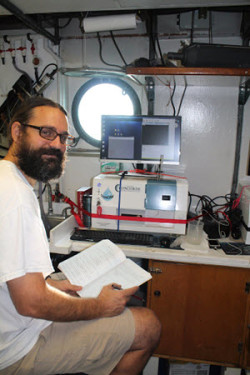
Adam takes notes in the R/V Point Sur’s lab while his FlowCam analyzes samples. (Photo by Alison Deary)
Adam studies the thin layers of plankton common in the coastal Gulf of Mexico water column. He measures the plankton’s photosynthesis processes to better understand their uptake and primary production rates of carbon. He also investigates how frequently other organisms, namely predatory microzooplankton, graze on these plankton concentrations. This information will help researchers understand how pollutants like oil move through the area and what living creatures they impact.
Adam collects seawater within the Mississippi Bight, a coastal environment dominated by river water plumes that mix and merge with the salty Gulf. He has joined other CONCORDE scientists on three larger research cruises and sampled on his own in small crafts. “When I’m not actually on a research cruise, I’m either preparing to go on one or analyzing data from a previous one,” he laughed.
Adam determines carbon uptake rates in his samples using an incubator called a photosynthetron, which simulates the in situ light environment and uses the resulting vertical light gradient to measure photosynthetic rates. He uses this information to calculate plankton’s carbon production and uptake and to estimate changes in phytoplankton abundance and growth over a 24-hour period.
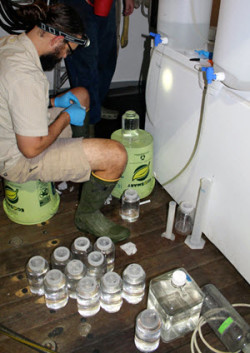
Adam works on dilution experiments during the early morning hours of a cruise. (Provided by Adam Boyette)
He also conducts experiments to examine grazing rates for microzooplankton feeding on phytoplankton. Then, he runs the samples through a particle imaging device called a FlowCAM to identify organisms in the water, allowing him to determine how many and which plankton and predatory microzooplankton species live in his study area.
Adam uses this information to understand the dynamics of nearshore microbial populations during various seasons. His calculations will be incorporated into a large ecological model that CONCORDE scientists are creating to represent the physical, chemical, and biological processes in the nearshore environment. “My motivation is to understand the connectivity between all things, to show how delicate the interplay is between the world we see and the microbial world,” he explained. “It’s a personal fascination.” Adam’s raw data collected through his CONCORDE research are available through the Gulf of Mexico Research Initiative Information and Data Cooperative (GRIIDC).
His Learning
“As Dr. Graham’s student, I’ve learned a lot about working collectively to achieve a common goal,” Adam said. “He’s provided wonderful leadership opportunities for emerging scientists to learn and grow.” One such opportunity came earlier this year, when Adam served as the chief scientist on an emergency three-day multi-consortia cruise to study the Bonnet Carré spillway opening, an action taken to protect New Orleans from rising Mississippi River floodwaters that sent millions of gallons of freshwater into the northern Gulf. He and other GoMRI scientists attending the Gulf of Mexico Oil Spill and Ecosystem Science Conference discussed how the unusual event might impact their study areas and planned the cruise.
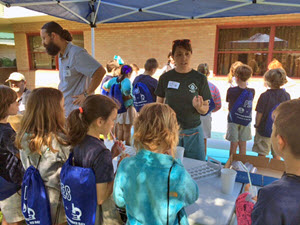
Adam and fellow graduate student Naomi Yoder teach Pontchartrain Elementary students about nearshore ecology during an Earth Science Day event. (Photo by Stephanie Watson)
The cruise included scientists from CONCORDE, DEEPEND, ECOGIG,CARTHE, and ACER. Adam took pleasure in seeing the process through from its somewhat chaotic inception to a highly organized research event, drawing on his experiences working in professional kitchens to keep everything running smoothly. The array of cross-disciplinary GoMRI scientists also helped make the project a success. “The most important thing I learned from this experience was to let go,” Adam said of his chief scientist position. “Put your trust in people and don’t try to be in control of everything. Instead, work with everyone and utilize their expertise – these people are here for a reason.”
His Future
Adam plans to finish his doctoral program in May 2018. He wants to continue researching plankton ecology using technologies such as satellite imaging and the FlowCam. His dream is to become an ongoing water quality project manager working for government agencies such as NOAA or the EPA or in a postdoctoral role at a university. “The oil spill has really shown the importance of long-term datasets,” Adam said.

Adam and fellow USM student Liesl Cole work in the R/V Point Sur’s highly secure radioisotope lab (known as the “rad van”) during the CONCORDE Spring Campaign. (Photo by Heather Dippold)
Praise for Adam
Monty Graham serves as both CONCORDE’s principle investigator and the Director of USM’s School of Ocean Science and Technology. He stated, “I can attest to Adam’s maturity, leadership potential, technical skills, and motivation and am thrilled that he is being recognized for his efforts.” Graham called Adam a critical member of the CONCORDE project, “He has been the student that his peers look up to, and a student that my research colleagues seek for advice. He pursues every opportunity to increase his knowledge within his chosen field, and has learned new technologies that are going to be applied widely in our studies.”
Graham explained that Adam shines in leadership roles, receiving “stellar reviews” from everyone involved in the Bonnet Carré cruise. “He has led his fellow students through trainings and scientific discussions and he is respected by his peers and senior scientists alike,” said Graham. “He is an excellent addition to the GoMRI Scholar program and is the definition of student success.”
The GoMRI community embraces bright and dedicated students like Adam Boyette and their important contributions. The GoMRI Scholars Program recognizes graduate students whose work focuses on GoMRI-funded projects and builds community for the next generation of ocean science professionals. Visit the CONCORDE website to learn more about their work.
************
This research was made possible in part by a grant from The Gulf of Mexico Research Initiative (GoMRI). The GoMRI is a 10-year independent research program established to study the effect, and the potential associated impact, of hydrocarbon releases on the environment and public health, as well as to develop improved spill mitigation, oil detection, characterization and remediation technologies. An independent and academic 20-member Research Board makes the funding and research direction decisions to ensure the intellectual quality, effectiveness and academic independence of the GoMRI research. All research data, findings and publications will be made publicly available. The program was established through a $500 million financial commitment from BP. For more information, visit http://gulfresearchinitiative.org/.

Bryan traveled to a Florida Strait sampling site to collect bacteria. He analyzed these samples to identify differences between microbial communities in the sea surface microlayer and underlying subsurface water. (Photo credit: Alexander Soloviev)
Bryan Hamilton never planned to be a microbiologist, but when the opportunity arose to study microbes that produce biosurfactant in response to oil exposure, he was drawn in completely. His research investigated the potential connection between these microbes and natural surface slicks and if this connection could help scientists detect oil below the water’s surface.
Bryan completed a marine biology masters’ degree at Nova Southeastern University while he was a GoMRI Scholar with CARTHE. He shared the research experiences that altered the path of his scientific career.
His Path
Bryan first saw the ocean when he was six years old during a family trip to the East Coast and became fascinated with the marine life he encountered. He realized then that he wanted to work in the marine environment when he grew up. After high school, he attended the Palm Beach Atlantic University to study marine biology.
Bryan credits his involvement with GoMRI research to Dr. Alexandre Soloviev who had a graduate student position available studying marine bacteria in his physical oceanography lab at Nova Southeastern University. Bryan was initially unsure of his interest in studying bacteria (he felt more like a shark guy), but was hooked when he learned he would be investigating sea-surface bacteria’s role in slick formation. “The research sounded like something I would love to be a part of,” he said. “That project was part of CARTHE and introduced me to many of the researchers I work with today.”
His Work
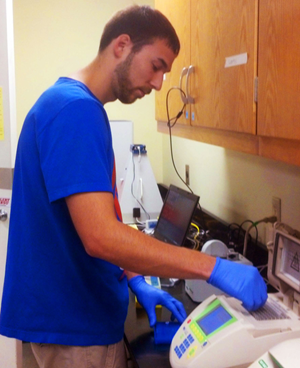
Bryan prepares a polymerase chain reaction to determine bacterial abundance in sea surface microlayer samples taken from the Florida Strait and Gulf of Mexico. (Photo credit: Cayla Dean)
Bryan explained that although the word “slick” is often associated with oil spills, these films on the water’s surface can occur for many reasons, including the accumulation of surfactants. Surfactants are compounds that help break up oil in the water column, resulting in smaller oil droplets. “Sea slicks formed by biosurfactants could serve as an indicator of the presence of organic matter in the water column,” he explained. “Surfactants travel to the surface, so it might be possible to determine if there is oil in the water column based on satellite images of natural surfactant slick formations.”
Bryan’s research focused on surfactant-producing bacteria living in or near the sea-surface microlayer (the upper 1 mm of the ocean where air meets sea). His team used Synthetic Aperture Radar (SAR) satellite imagery to identify slicks across the Gulf of Mexico and Florida Straight. He then conducted DNA analysis on bacteria collected from these areas to detect differences in the abundance of surfactant-producing bacteria under slick and non-slick conditions. His observations appear to support a microbe-slick connection, as there was a higher abundance of these bacteria in slick areas compared to non-slick areas.
Bryan believes that learning more about the microbes that are active in the air-sea interface will help researchers better understand sea-surface oil transport. “Bacteria are so important to the ocean ecosystem,” he said. “The potential links between microbial life and surface features seen in satellite images may help improve recovery efforts and strategies.”
His Learning
Bryan called his work with Soloviev his “first real taste of research” that prepared him for the scientific field. The trial-and-error process of designing more efficient sampling techniques was at first frustrating, but he and Soloviev were able to make improvements as they continued. “I learned that there is a lot more to research than conducting an experiment and seeing what you find,” said Bryan. “There are often many attempts and failures before you figure out the best way to do something.”
Through his work with CARTHE, Bryan discovered how eager other scientists were to collaborate. His most memorable experience was participating in CARTHE’s Surfzone Coastal Oil Pathways Experiment (SCOPE), which used drifters, dye, and drones to research the mechanisms that move water-borne materials onshore. During the event, everyone’s willingness to help with each other’s experiments impressed Bryan, “It was quite a large group of people, so teamwork was extremely important to the experiment’s success. It was great to see everyone working together to solve a problem.”
His Future
Bryan recently completed his masters’ degree and accepted a molecular biologist position near Miami, but remains open to the possibility of pursuing a Ph.D. He said that the lab work involved in his CARTHE research gave him the necessary experience for the job. “My GoMRI experience really opened up my options for a career after graduate school, especially since genetic work can be applied to wide range of fields.”
Bryan suggested that future science students should get involved in as many activities and volunteer opportunities that they can, even if the work is outside of their direct interests. He explained that getting involved with other researchers can open up new opportunities and lead to connections with people in your area of interest. “You never know who you will meet or what you will learn through those experiences,” he said.
Praise for Bryan
Soloviev described Bryan as a “bright, hard-working young researcher who goes above and beyond to understand complex biophysical problems.” He praised Bryan’s contributions to the development of a microlayer sampling technique that reduces interference from the research ship, ship wake, and researcher activities. The improved technique was implemented during the SCOPE program and made sample collection more efficient and possible across a wider range of wind-wave conditions, resulting in more samples being collected, improving the project’s statistics.
Soloviev also noted Bryan’s other accomplishments, including oral presentations at major national and international conferences in 2014 (the International Geoscience and Remote Sensing Symposium in Canada and the Earth Observation for Ocean-Atmosphere Interactions Science conference in Italy) and his recent article in the Canadian Journal of Remote Sensing.
The GoMRI community embraces bright and dedicated students like Bryan Hamilton and their important contributions. The GoMRI Scholars Program recognizes graduate students whose work focuses on GoMRI-funded projects and builds community for the next generation of ocean science professionals.
Visit the CARTHE website to learn more about their work.
************
This research was made possible in part by a grant from BP/The Gulf of Mexico Research Initiative (GoMRI) to the Consortium for Advanced Research on Transport of Hydrocarbon in the Environment (CARTHE) I and II. The GoMRI is a 10-year independent research program established to study the effect, and the potential associated impact, of hydrocarbon releases on the environment and public health, as well as to develop improved spill mitigation, oil detection, characterization and remediation technologies. An independent and academic 20-member Research Board makes the funding and research direction decisions to ensure the intellectual quality, effectiveness and academic independence of the GoMRI research. All research data, findings and publications will be made publicly available. The program was established through a $500 million financial commitment from BP. For more information, visit http://gulfresearchinitiative.org/.
Boryoung Shin is breaking new ground in microbiology, uncovering little known facts about an enigmatic and important species in the Gulf of Mexico.

Boryoung Shin works in an anaerobic chamber at the Kostka Lab at Georgia Tech. (Photo credit: Max Kolton)
After the Deepwater Horizon incident, certain bacteria rapidly increased and helped degrade the oil. These microbes, who consume naturally-occurring hydrocarbons, rise and fall in number as access to their preferred food supply changes. Boryoung’s research focuses on a subset of this group, the oil-eating bacteria that live deep within seafloor sediment.
A Ph.D. student in Earth and Atmospheric Sciences (EAS) at the Georgia Institute of Technology, Boryoung is a GoMRI scholar with the Deep-C consortium. She shares her journey from South Korea to the depths of the Gulf.
Her Path
When Boryoung was a high school student, she read a magazine article about deep ocean-dwelling creatures that changed her life. She became fixated on the idea of making deep sea ecology her future work. However, geography was a major hurdle as Boryoung had a difficult time locating courses that fit her needs. She explained that marine science programs can be hard to find in Korea: “It’s just not commonly studied.”
Boryoung’s persistence paid off, though, and she found an environmental marine science undergraduate program at the Hanyang University. Luckily, her next favorite subject was English. After obtaining a bachelor’s degree, she searched graduate programs at American universities to pursue her growing passion for microbial ecology. The work of Georgia Tech Professor Joel Kostka on the bacterial populations that consumed oil after the Deepwater Horizon spill impressed Boryoung. In 2012, she enrolled in the EAS Ph.D. program and, under Kostka’s direction, began research on sediment-dwelling microbes.
Her Work

The crew of the RV Weatherbird II collects sediment samples for Boryoung’s projects. Pictured from far left: Arvind Shantharam, Caroline Johansen, Ben LeBelle, Curtis Okolovitch, and Boryoung. (Photo credit: Ian MacDonald)
Oil-eating microbial communities that live in the water column and top layers of sediment need oxygen to survive. However, microbes that live deeper within Gulf sediments are anaerobic – they can live without oxygen.
Boryoung explained that oil can linger for a long time in sediment, an environment where there is little to no light or oxygen to assist degradation. The microbes she studies are one of the only means of breaking down oil once it has become buried in an anaerobic zone. To learn how these microbes operate, she cultivates Gulf sediment samples collected during a research cruise in June 2014 aboard the RV Weatherbird II. On that expedition, she collected sediment at over 1,000 meters depth for her lab work.
In the lab, she monitors these sediment-dwelling bacteria, a process that requires much patience. Anaerobic bacteria grow incredibly slowly – a year or more can pass before there is measurable activity in her cultures. Boryoung isolates these microbes, enriches them with various nutrients, and observes their community structure response. She analyzes their DNA to determine the succession of microbial groups that follows after oil exposure.
Boryoung laughs, “This process can take so long that I sometimes find myself asking, ‘What am I doing?’ I have to give myself pep talks that this is worth the wait, that it’s valuable science.”
Her results have been worth the wait. Many of these anaerobic microbial groups are not closely related to known hydrocarbon-degrading bacteria. As one of the first scientists to describe these populations, Boryoung has identified unique oil-degrading bacterial communities under sulfate- and iron-reducing conditions. Her long-term goal is to use her results to guide oil spill response efforts and uncover new potential methods for bioremediation.
Her Learning

Boryoung cultivates anaerobic bacteria populations in a Gulf of Mexico sediment sample housed at Georgia Tech. (Photo credit: Boryoung Shin)
Boryoung’s first research cruise was more difficult than she expected. She did not sleep well and was frustrated with very limited communications on board. But she really enjoyed working with the helpful and friendly crew and research team. Overcoming these obstacles made it that much more rewarding when she successfully completed her mission. Boryoung is greatly looking forward to using her newly-acquired sea skills on an expedition this August.
As much as she enjoys fieldwork, her favorite aspect of research is the science community she has joined. “The people I meet at GoMRI conferences really inspire me,” Boryoung said, referring to the annual Gulf of Mexico Oil Spill and Ecosystem Science conferences. She explained that the researchers she has met are very supportive of one another’s work. Calling it a synergistic relationship, she said, “We help each other, share ideas, and learn from one other.”
Her Future
As Boryoung continues her research with C-IMAGE, she is considering both academic and industry jobs once she completes her Ph.D. An aspect that draws her to academia is the concept of solving problems. She encourages other young people to choose science as a career so that more researchers can work together for the benefit of the Earth and people. She also hopes to continue living in the U.S.
“I want to be a ‘real’ scientist wherever I am,” Boryoung jokes. “Seriously, I like the culture here in the United States and this is where the work is for the most part. I hope I’m privileged enough to stay.”
Praise for Boryoung

Boryoung with her cohorts at the Kostka lab. From far left: Patrick Steck, Will Overholt, Xiaoxu Sun, John C. Gaby, Boryoung Shin, Kaitlin Esson, and Joel Kostka. (Photo courtesy of Deep-C)
Kostka describes Boryoung as a bright and dedicated young researcher, noting the tremendous amount of progress she has made in advancing anaerobic microbiology since she arrived at Georgia Tech. “She has the hardest job of any of my students,” said Kostka. He continued, “Hydrocarbon degrading bacteria grow very slowly under anaerobic conditions, and it usually takes Boryoung about one year to do a single experiment.” He said that Boryoung has isolated some cultures of anaerobic oil-degrading bacteria and is using molecular techniques to understand the processing of oil hydrocarbons in anaerobic sediments. Kostka also commented that aside from her academic capabilities, Boryoung is a pleasure to work with. “She nearly always has a smile on her face and a kind word for her colleagues. Her language skills are amazing, and she has embraced the American culture from the beginning of her tenure in Atlanta.” Kostka sees a bright future in science for Boryoung.
The GoMRI community embraces bright and dedicated students like Boryoung and their important contributions. The Scholars Program recognizes graduate students whose work focuses on GoMRI-funded projects and builds community for the next generation of ocean science professionals.
Visit the Deep-C website to learn more about their work.
************
This research was made possible in part by a grant from BP/The Gulf of Mexico Research Initiative (GoMRI) to theDeepsea to Coast Connectivity in the Eastern Gulf of Mexico (DEEP-C) consortium.
The GoMRI is a 10-year independent research program established to study the effect, and the potential associated impact, of hydrocarbon releases on the environment and public health, as well as to develop improved spill mitigation, oil detection, characterization and remediation technologies. An independent and academic 20-member Research Board makes the funding and research direction decisions to ensure the intellectual quality, effectiveness and academic independence of the GoMRI research. All research data, findings and publications will be made publicly available. The program was established through a $500 million financial commitment from BP. For more information, visit http://gulfresearchinitiative.org/.
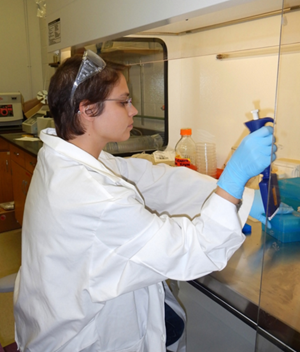
Sarah transfers DNA samples from single-cell organisms in the lab at University of West Florida. (Photo credit: Richard Snyder)
To show how the Deepwater Horizon oil spill impacted the Gulf of Mexico, Sarah Tominack is going back to basics.
She feels that for scientists to quickly identify the Gulf in distress, they must have a better picture of what “normal” looks like, particularly for microscopic single-celled organisms at the marine food web base called archaea.
Understanding these tiny creatures, which are at the whim of their environment because they do not have the ability to move, could provide additional insight about what happens when pollutants enter their world. “We really don’t know much about how they work or why they live where they live,” explains Sarah, so she is working to uncover their everyday dynamics.
Sarah is a GoMRI scholar working with Deep-C scientists at the University of West Florida (UWF). Here she describes her process and what she has discovered so far.
Her Path

Sarah collects sediment samples for DNA analysis on board the Florida Institute of Oceanography R/V Bellows. (Photo Credit: Richard Snyder)
Coming from a family of science-minded individuals, Sarah loved to explore the world around her. “Running through the woods as a kid, I was always interested in why I found certain critters where I found them,” says Sarah. “As time went on, I began to realize that everything was somehow related.” Understanding that all living things were linked gave her a thirst for knowledge in a variety of subjects. She went from class to class, loving every new subject more than the last, culminating with an undergraduate degree from the University of North Alabama in environmental biology with two minors—chemistry and Spanish—because she could not make up her mind which subject she enjoyed most. Always at the top of her list, however, was seeking information about relationships in nature.
Sarah’s graduation in December of 2012 coincided perfectly with the opportunity to join Wade Jeffrey and Richard Snyder at UWF’s Center for Environmental Diagnostics and Bioremediation. The pair were co-Principle Investigators on a Deep-C research project seeking to establish baseline information on microbial and biogeochemical processes in the northeastern Gulf. The prospect of working with biologists, chemists, and ecologists to better understand the marine environment was a perfect fit for her interests.
Her Work
Sarah describes the importance of microbes like archaea using a pyramid analogy. As the base of the pyramid, the microbial world’s structure, stability, and function affects every life level above it—even humans. With this in mind, her particular research does not focus on oil’s impacts on microbes, but on understanding their system when it is healthy. “If we do not have a good characterization of the dynamics of microbial populations before a catastrophe,” explains Sarah, “we cannot predict what will happen during and after a catastrophe.”

Sarah processes samples for polymerase chain reaction (PCR) amplification of Archea DNA sequences. (Photo credit: Richard Snyder)
Sarah joined six research expeditions to collect data. She went out in different seasons, tracing the same path three days in a row each trip. Her team deployed equipment that obtained samples while measuring temperature, salinity, and oxygen levels. Back in the lab, Sarah extracted the archaea from the samples and used bioinformatics—the computational side of DNA analysis—to learn about how the different species of archaea relate to one another and how natural fluctuations in the Gulf impact their life cycle.
She is finding that archaea populations living in the nearshore coastal waters and deep waters (below 100 meters) stay fairly stable throughout the seasons. However, archaea living near the water surface of the open Gulf disappear during the hot summer months. She hypothesizes that because the tiny creatures cannot swim, they die out from starvation as brilliant blue offshore surface water that is low in nutrients takes over the continental shelf. Then, the population reestablishes itself in the winter months when the water cools and archaea churn up from the bottom as the water layers naturally mix again.
Her Learning
Sarah says working with Deep-C has improved her as a scientist on every level. Not only has she become comfortable with collaborative efforts between different disciplines, but also she has learned how to present her findings to other researchers. Conferences provided opportunities to share her research via talks and posters and to network with other scientists in related fields. She says it is just as important to discuss failures as successes in these instances, because “you never know who will help you solve the problem.”
Sarah found the Student Symposium hosted by Deep-C particularly meaningful, giving her a chance to practice her presentation skills in front of friendly faces. In addition, the many opportunities provided to interact with senior scientists helped her become comfortable picking their brains. Calling it an “irreplaceable experience,” Sarah says, “It was set up in a way that I could ask all of the questions I never knew I had.” Instead of finding senior scientists intimidating, she discovered that they were more than willing to lend an ear—or a hand.
Her Future

Sarah operates the computer station for oceanographic data and water column sample collection on board the Florida Institute of Oceanography R/V Bellows. (Photo credit: Richard Snyder)
Sarah just completed her master’s degree in biology. Before pursuing a Ph.D., she wants to experience more of the world. To that end, she has committed to spend a year working with Habitat for Humanity through the AmeriCorps program. “I am ready to broaden my horizons as a person and gain new perspectives as a scientist in the community,” she explains. In the spring, Sarah will also teach an undergraduate course in Aquatic Botany at UWF.
Praise for Sarah
Sarah’s advisors, UWF biologists Richard Snyder and Wade Jeffrey describe her as highly motivated, enthusiastic, dedicated, and competent. Snyder recalls that Sarah was very hard on herself in the beginning of her graduate program, concerned that she would not be able to learn shipboard collection procedures and that seasickness might incapacitate her. “As it turns out, she was one of few that did not get sick and quickly became the reliable ‘go to’ person on board,” he remembers. “She ended up being one of our very best in the scientific crew.”
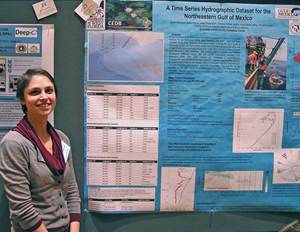
Sarah Tominack shares her research at the GOMRI Oil Spill Research Conference Mobile, Alabama in January 2014. (Photo credit: Richard Synder)
Sarah’s mastery of molecular biology lab processes quickly became apparent on shore as well. She took the lead, learning computer routines for DNA sequence data processing and analysis and then teaching it to other students. Snyder said, “By her own initiative, she became the in-house expert on not only the bioinformatics tools needed, but also the management, plotting, and analysis of oceanographic data and multivariate statistical analysis—no small feats in themselves!” Jeffrey concurs, “She showed great initiative in taking on much of the computer work and bioinformatics required of our projects.”
Though Sarah’s advisors are excited for her as she goes off to her next adventure, they will miss her greatly. Snyder summed up what a great asset she has been, saying that in his eyes, Sarah is a “master’s student with Ph.D. level competence.”
The GoMRI community embraces bright and dedicated students like Sarah and their important contributions. The GoMRI Scholars Program recognizes graduate students whose work focuses on GoMRI-funded projects and builds community for the next generation of ocean science professionals.
(Photo credits: Richard Snyder)
Visit the Deep-C website to learn more about their work.
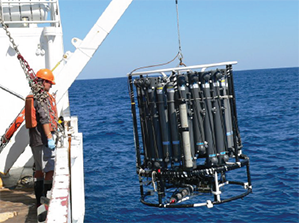
Researcers deploy a water sampling device to measure conductivity, temperature and depth (CTD) at different points of the water column. Photo credit: Alan Shiller USM
Since the explosion of the Deepwater Horizon oil rig, scientists from a variety of backgrounds have been hard at work collecting samples to monitor the effects of the oil on marine environments. Dr. Alan Shiller, a chemical oceanographer from the University of Southern Mississippi (USM), has been studying both direct and indirect chemical effects from the spill. Direct effects include the spread of crude oil and the physical and chemical changes of the oil over time while indirect effects pertain to changes in natural ocean processes. This includes the prevention of exchange of oxygen at the surface of the water because of the presence of an oil slick. His observations provide other oil spill researchers with valuable information in seeking to understand ecosystem effects of the oil spill.
Classroom Activity: Oil-Munching Microbes
Oil, from natural seeps in the ocean floor, continuously flows into the environment. Some microbes, including bacteria, are specially adapted to survive exposure to hydrocarbons and are even able to use it as food. In this lesson, students will learn about natural oil seeps, the Gulf of Mexico oil spill, and how microbes are helping clean up our environment. An experiment may be added to this lesson so students can observe and evaluate the effectiveness of oil-eating microbes.
Chemical Effects of the Oil Spill Mississippi Sound – PDF 866KB